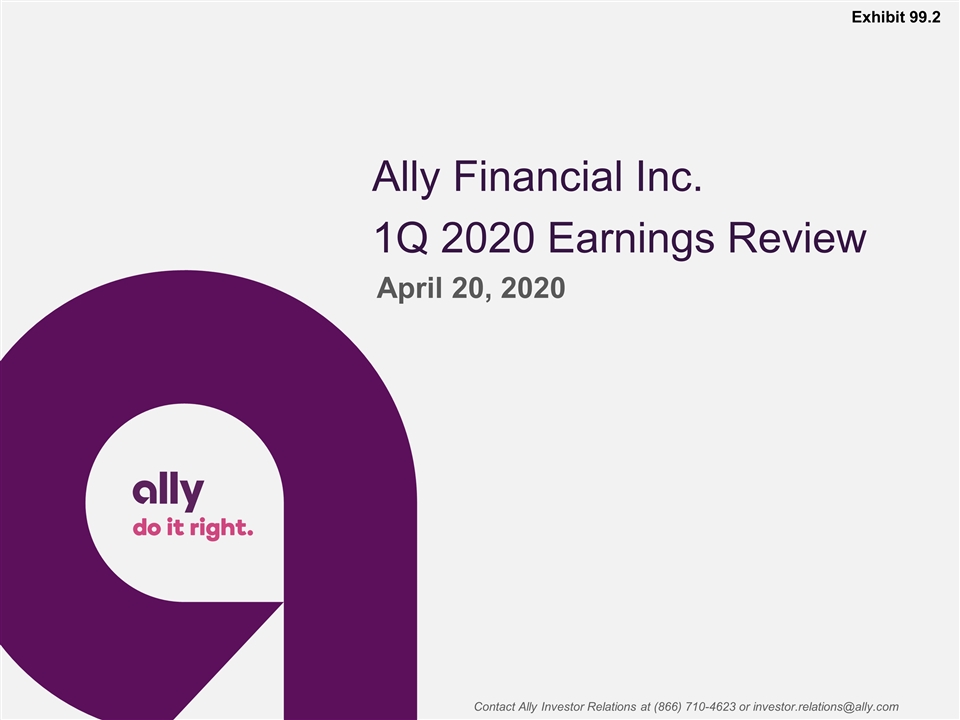
Ally Financial Inc. 1Q 2020 Earnings Review April 20, 2020 Contact Ally Investor Relations at (866) 710-4623 or investor.relations@ally.com Exhibit 99.2
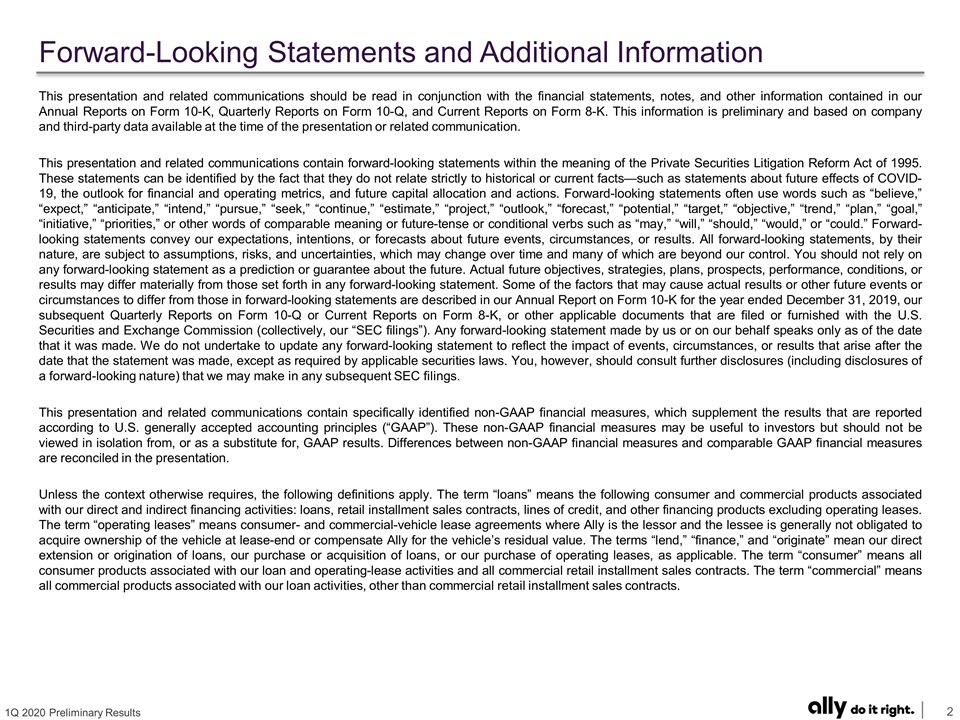
Forward-Looking Statements and Additional Information This presentation and related communications should be read in conjunction with the financial statements, notes, and other information contained in our Annual Reports on Form 10-K, Quarterly Reports on Form 10-Q, and Current Reports on Form 8-K. This information is preliminary and based on company and third-party data available at the time of the presentation or related communication. This presentation and related communications contain forward-looking statements within the meaning of the Private Securities Litigation Reform Act of 1995. These statements can be identified by the fact that they do not relate strictly to historical or current facts—such as statements about future effects of COVID-19, the outlook for financial and operating metrics, and future capital allocation and actions. Forward-looking statements often use words such as “believe,” “expect,” “anticipate,” “intend,” “pursue,” “seek,” “continue,” “estimate,” “project,” “outlook,” “forecast,” “potential,” “target,” “objective,” “trend,” “plan,” “goal,” “initiative,” “priorities,” or other words of comparable meaning or future-tense or conditional verbs such as “may,” “will,” “should,” “would,” or “could.” Forward-looking statements convey our expectations, intentions, or forecasts about future events, circumstances, or results. All forward-looking statements, by their nature, are subject to assumptions, risks, and uncertainties, which may change over time and many of which are beyond our control. You should not rely on any forward-looking statement as a prediction or guarantee about the future. Actual future objectives, strategies, plans, prospects, performance, conditions, or results may differ materially from those set forth in any forward-looking statement. Some of the factors that may cause actual results or other future events or circumstances to differ from those in forward-looking statements are described in our Annual Report on Form 10-K for the year ended December 31, 2019, our subsequent Quarterly Reports on Form 10-Q or Current Reports on Form 8-K, or other applicable documents that are filed or furnished with the U.S. Securities and Exchange Commission (collectively, our “SEC filings”). Any forward-looking statement made by us or on our behalf speaks only as of the date that it was made. We do not undertake to update any forward-looking statement to reflect the impact of events, circumstances, or results that arise after the date that the statement was made, except as required by applicable securities laws. You, however, should consult further disclosures (including disclosures of a forward-looking nature) that we may make in any subsequent SEC filings. This presentation and related communications contain specifically identified non-GAAP financial measures, which supplement the results that are reported according to U.S. generally accepted accounting principles (“GAAP”). These non-GAAP financial measures may be useful to investors but should not be viewed in isolation from, or as a substitute for, GAAP results. Differences between non-GAAP financial measures and comparable GAAP financial measures are reconciled in the presentation. Unless the context otherwise requires, the following definitions apply. The term “loans” means the following consumer and commercial products associated with our direct and indirect financing activities: loans, retail installment sales contracts, lines of credit, and other financing products excluding operating leases. The term “operating leases” means consumer- and commercial-vehicle lease agreements where Ally is the lessor and the lessee is generally not obligated to acquire ownership of the vehicle at lease-end or compensate Ally for the vehicle’s residual value. The terms “lend,” “finance,” and “originate” mean our direct extension or origination of loans, our purchase or acquisition of loans, or our purchase of operating leases, as applicable. The term “consumer” means all consumer products associated with our loan and operating-lease activities and all commercial retail installment sales contracts. The term “commercial” means all commercial products associated with our loan activities, other than commercial retail installment sales contracts.
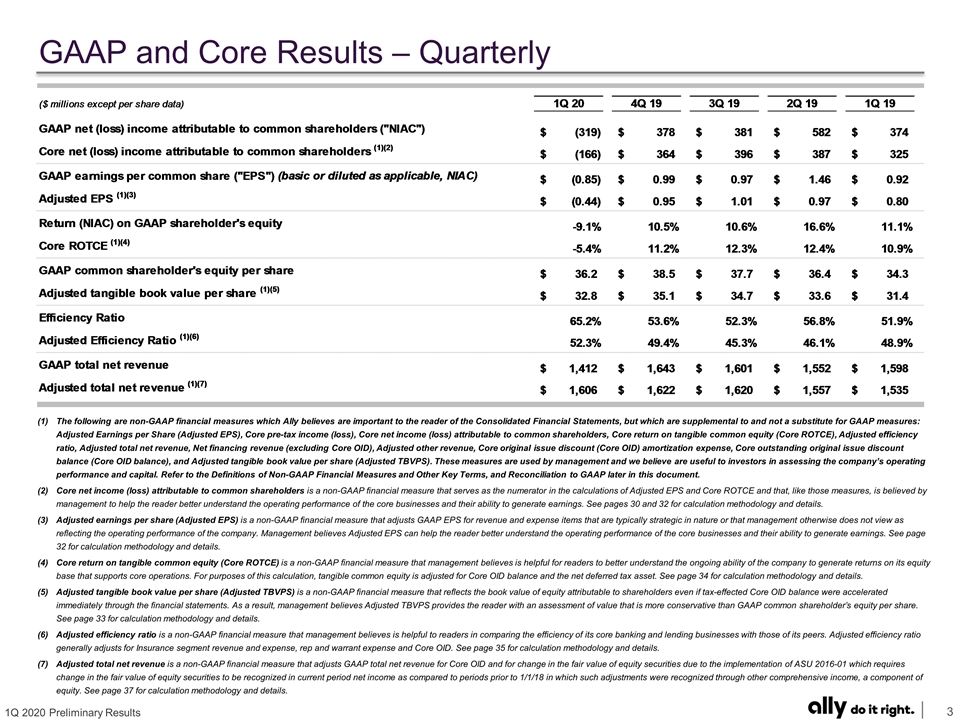
GAAP and Core Results – Quarterly The following are non-GAAP financial measures which Ally believes are important to the reader of the Consolidated Financial Statements, but which are supplemental to and not a substitute for GAAP measures: Adjusted Earnings per Share (Adjusted EPS), Core pre-tax income (loss), Core net income (loss) attributable to common shareholders, Core return on tangible common equity (Core ROTCE), Adjusted efficiency ratio, Adjusted total net revenue, Net financing revenue (excluding Core OID), Adjusted other revenue, Core original issue discount (Core OID) amortization expense, Core outstanding original issue discount balance (Core OID balance), and Adjusted tangible book value per share (Adjusted TBVPS). These measures are used by management and we believe are useful to investors in assessing the company’s operating performance and capital. Refer to the Definitions of Non-GAAP Financial Measures and Other Key Terms, and Reconciliation to GAAP later in this document. Core net income (loss) attributable to common shareholders is a non-GAAP financial measure that serves as the numerator in the calculations of Adjusted EPS and Core ROTCE and that, like those measures, is believed by management to help the reader better understand the operating performance of the core businesses and their ability to generate earnings. See pages 30 and 32 for calculation methodology and details. Adjusted earnings per share (Adjusted EPS) is a non-GAAP financial measure that adjusts GAAP EPS for revenue and expense items that are typically strategic in nature or that management otherwise does not view as reflecting the operating performance of the company. Management believes Adjusted EPS can help the reader better understand the operating performance of the core businesses and their ability to generate earnings. See page 32 for calculation methodology and details. Core return on tangible common equity (Core ROTCE) is a non-GAAP financial measure that management believes is helpful for readers to better understand the ongoing ability of the company to generate returns on its equity base that supports core operations. For purposes of this calculation, tangible common equity is adjusted for Core OID balance and the net deferred tax asset. See page 34 for calculation methodology and details. Adjusted tangible book value per share (Adjusted TBVPS) is a non-GAAP financial measure that reflects the book value of equity attributable to shareholders even if tax-effected Core OID balance were accelerated immediately through the financial statements. As a result, management believes Adjusted TBVPS provides the reader with an assessment of value that is more conservative than GAAP common shareholder’s equity per share. See page 33 for calculation methodology and details. Adjusted efficiency ratio is a non-GAAP financial measure that management believes is helpful to readers in comparing the efficiency of its core banking and lending businesses with those of its peers. Adjusted efficiency ratio generally adjusts for Insurance segment revenue and expense, rep and warrant expense and Core OID. See page 35 for calculation methodology and details. Adjusted total net revenue is a non-GAAP financial measure that adjusts GAAP total net revenue for Core OID and for change in the fair value of equity securities due to the implementation of ASU 2016-01 which requires change in the fair value of equity securities to be recognized in current period net income as compared to periods prior to 1/1/18 in which such adjustments were recognized through other comprehensive income, a component of equity. See page 37 for calculation methodology and details.
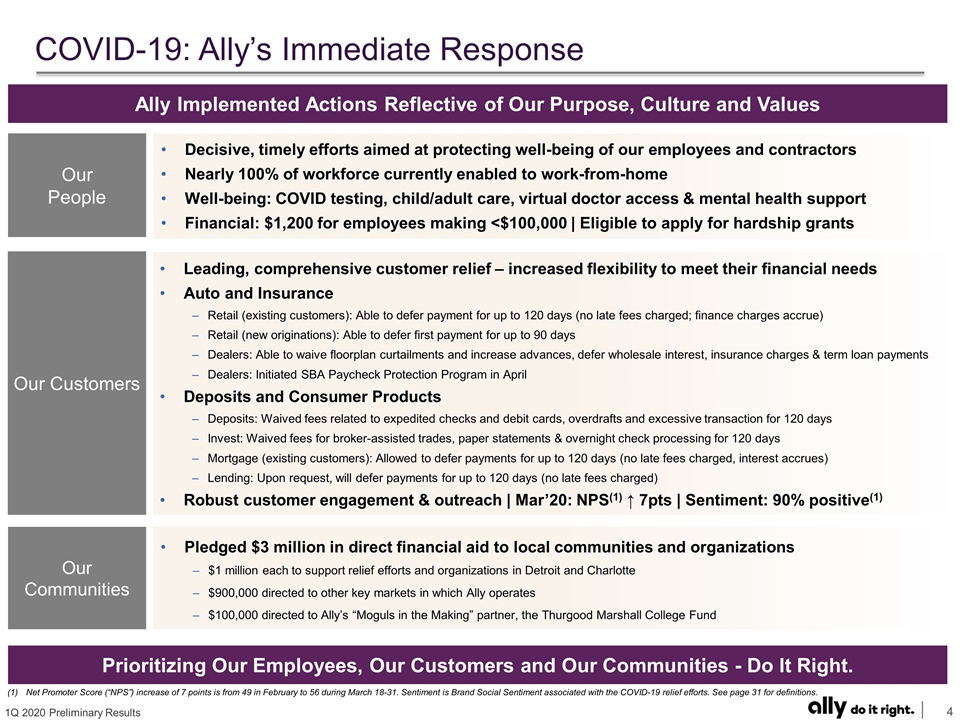
Leading, comprehensive customer relief – increased flexibility to meet their financial needs Auto and Insurance Retail (existing customers): Able to defer payment for up to 120 days (no late fees charged; finance charges accrue) Retail (new originations): Able to defer first payment for up to 90 days Dealers: Able to waive floorplan curtailments and increase advances, defer wholesale interest, insurance charges & term loan payments Dealers: Initiated SBA Paycheck Protection Program in April Deposits and Consumer Products Deposits: Waived fees related to expedited checks and debit cards, overdrafts and excessive transaction for 120 days Invest: Waived fees for broker-assisted trades, paper statements & overnight check processing for 120 days Mortgage (existing customers): Allowed to defer payments for up to 120 days (no late fees charged, interest accrues) Lending: Upon request, will defer payments for up to 120 days (no late fees charged) Robust customer engagement & outreach | Mar’20: NPS(1) ↑ 7pts | Sentiment: 90% positive(1) COVID-19: Ally’s Immediate Response Decisive, timely efforts aimed at protecting well-being of our employees and contractors Nearly 100% of workforce currently enabled to work-from-home Well-being: COVID testing, child/adult care, virtual doctor access & mental health support Financial: $1,200 for employees making <$100,000 | Eligible to apply for hardship grants Our People Our Customers Our Communities Pledged $3 million in direct financial aid to local communities and organizations $1 million each to support relief efforts and organizations in Detroit and Charlotte $900,000 directed to other key markets in which Ally operates $100,000 directed to Ally’s “Moguls in the Making” partner, the Thurgood Marshall College Fund Ally Implemented Actions Reflective of Our Purpose, Culture and Values Prioritizing Our Employees, Our Customers and Our Communities - Do It Right. Net Promoter Score (“NPS”) increase of 7 points is from 49 in February to 56 during March 18-31. Sentiment is Brand Social Sentiment associated with the COVID-19 relief efforts. See page 31 for definitions.
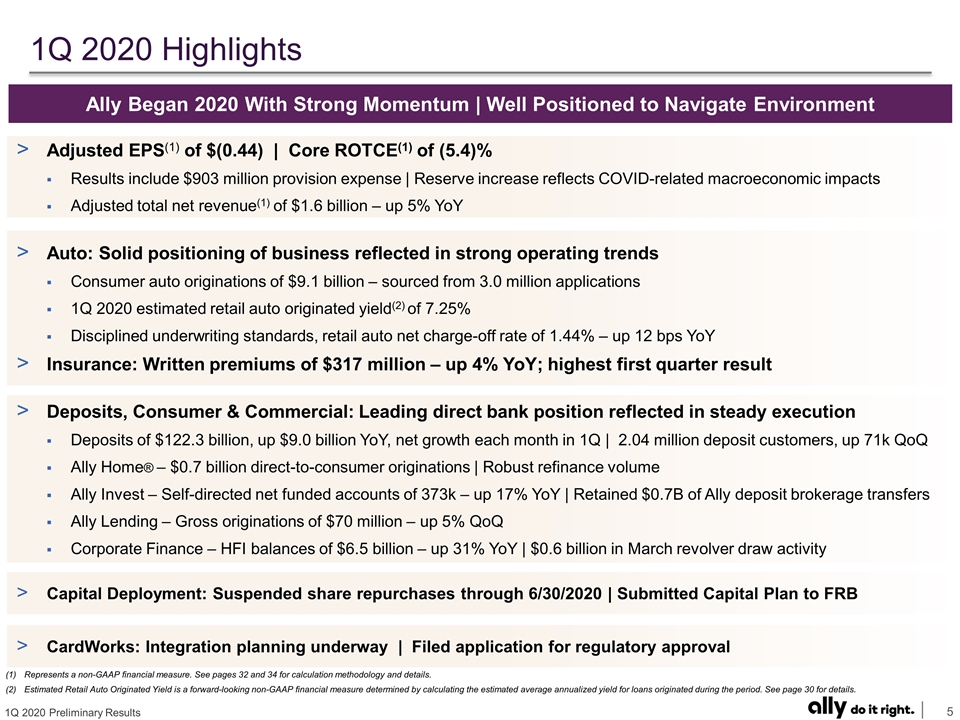
1Q 2020 Highlights Adjusted EPS(1) of $(0.44) | Core ROTCE(1) of (5.4)% Results include $903 million provision expense | Reserve increase reflects COVID-related macroeconomic impacts Adjusted total net revenue(1) of $1.6 billion – up 5% YoY Auto: Solid positioning of business reflected in strong operating trends Consumer auto originations of $9.1 billion – sourced from 3.0 million applications 1Q 2020 estimated retail auto originated yield(2) of 7.25% Disciplined underwriting standards, retail auto net charge-off rate of 1.44% – up 12 bps YoY Insurance: Written premiums of $317 million – up 4% YoY; highest first quarter result Deposits, Consumer & Commercial: Leading direct bank position reflected in steady execution Deposits of $122.3 billion, up $9.0 billion YoY, net growth each month in 1Q | 2.04 million deposit customers, up 71k QoQ Ally Home® – $0.7 billion direct-to-consumer originations | Robust refinance volume Ally Invest – Self-directed net funded accounts of 373k – up 17% YoY | Retained $0.7B of Ally deposit brokerage transfers Ally Lending – Gross originations of $70 million – up 5% QoQ Corporate Finance – HFI balances of $6.5 billion – up 31% YoY | $0.6 billion in March revolver draw activity Ally Began 2020 With Strong Momentum | Well Positioned to Navigate Environment Represents a non-GAAP financial measure. See pages 32 and 34 for calculation methodology and details. Estimated Retail Auto Originated Yield is a forward-looking non-GAAP financial measure determined by calculating the estimated average annualized yield for loans originated during the period. See page 30 for details. Capital Deployment: Suspended share repurchases through 6/30/2020 | Submitted Capital Plan to FRB CardWorks: Integration planning underway | Filed application for regulatory approval
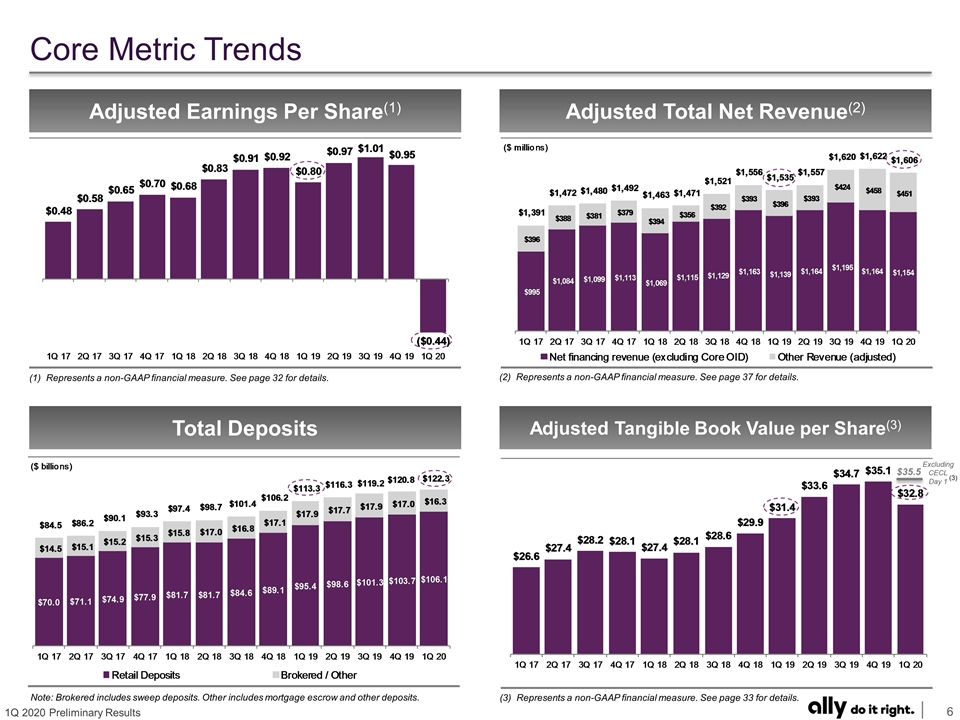
Adjusted Earnings Per Share(1) Adjusted Total Net Revenue(2) Total Deposits Adjusted Tangible Book Value per Share(3) Core Metric Trends (2) Represents a non-GAAP financial measure. See page 37 for details. (1) Represents a non-GAAP financial measure. See page 32 for details. (3) Represents a non-GAAP financial measure. See page 33 for details. Note: Brokered includes sweep deposits. Other includes mortgage escrow and other deposits. $35.5 Excluding CECL Day 1 (3)
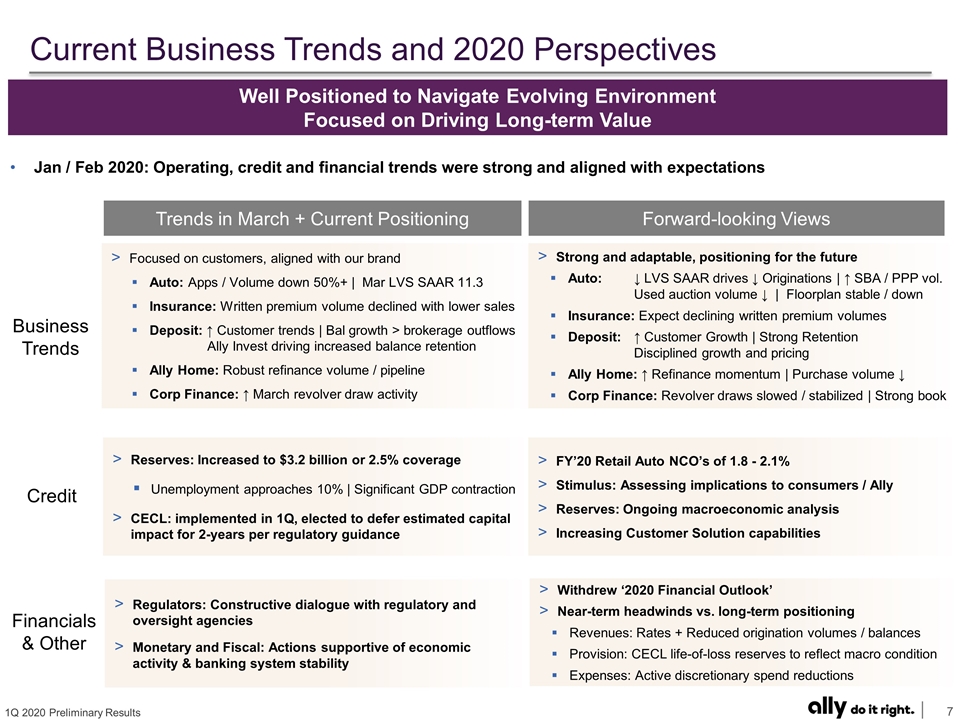
Current Business Trends and 2020 Perspectives Focused on customers, aligned with our brand Auto: Apps / Volume down 50%+ | Mar LVS SAAR 11.3 Insurance: Written premium volume declined with lower sales Deposit: ↑ Customer trends | Bal growth > brokerage outflows Ally Invest driving increased balance retention Ally Home: Robust refinance volume / pipeline Corp Finance: ↑ March revolver draw activity Business Trends Credit Financials & Other Reserves: Increased to $3.2 billion or 2.5% coverage Unemployment approaches 10% | Significant GDP contraction CECL: implemented in 1Q, elected to defer estimated capital impact for 2-years per regulatory guidance Well Positioned to Navigate Evolving Environment Focused on Driving Long-term Value Trends in March + Current Positioning Forward-looking Views Strong and adaptable, positioning for the future Auto: ↓ LVS SAAR drives ↓ Originations | ↑ SBA / PPP vol. Used auction volume ↓ | Floorplan stable / down Insurance: Expect declining written premium volumes Deposit: ↑ Customer Growth | Strong Retention Disciplined growth and pricing Ally Home: ↑ Refinance momentum | Purchase volume ↓ Corp Finance: Revolver draws slowed / stabilized | Strong book FY’20 Retail Auto NCO’s of 1.8 - 2.1% Stimulus: Assessing implications to consumers / Ally Reserves: Ongoing macroeconomic analysis Increasing Customer Solution capabilities Regulators: Constructive dialogue with regulatory and oversight agencies Monetary and Fiscal: Actions supportive of economic activity & banking system stability Withdrew ‘2020 Financial Outlook’ Near-term headwinds vs. long-term positioning Revenues: Rates + Reduced origination volumes / balances Provision: CECL life-of-loss reserves to reflect macro condition Expenses: Active discretionary spend reductions Jan / Feb 2020: Operating, credit and financial trends were strong and aligned with expectations
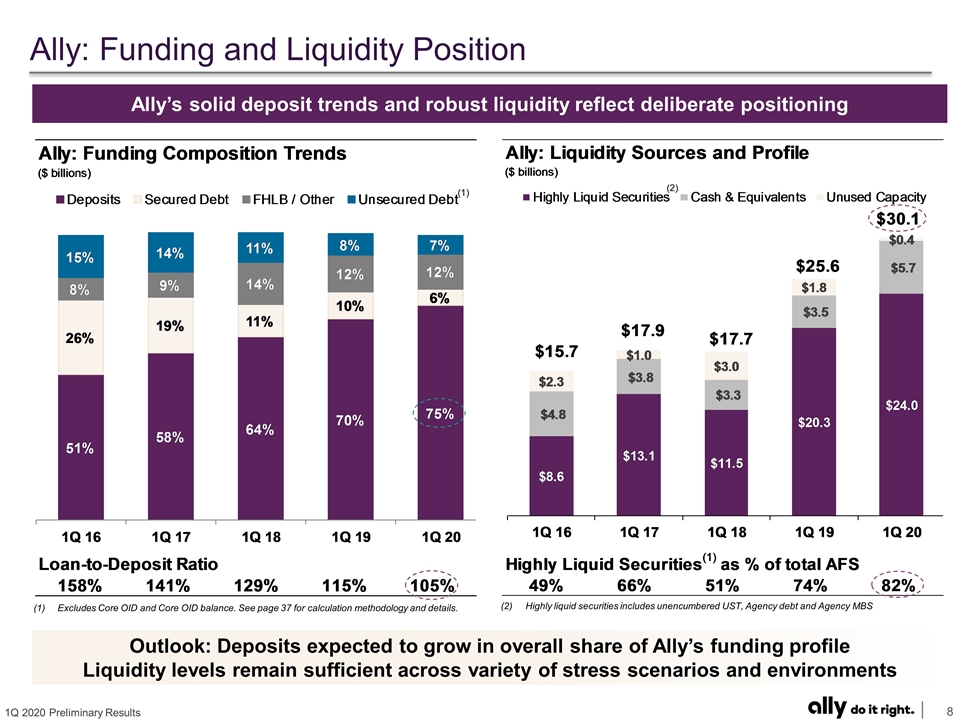
Ally: Funding and Liquidity Position Outlook: Deposits expected to grow in overall share of Ally’s funding profile Liquidity levels remain sufficient across variety of stress scenarios and environments Ally’s solid deposit trends and robust liquidity reflect deliberate positioning (2) Highly liquid securities includes unencumbered UST, Agency debt and Agency MBS (2) Excludes Core OID and Core OID balance. See page 37 for calculation methodology and details. (1)
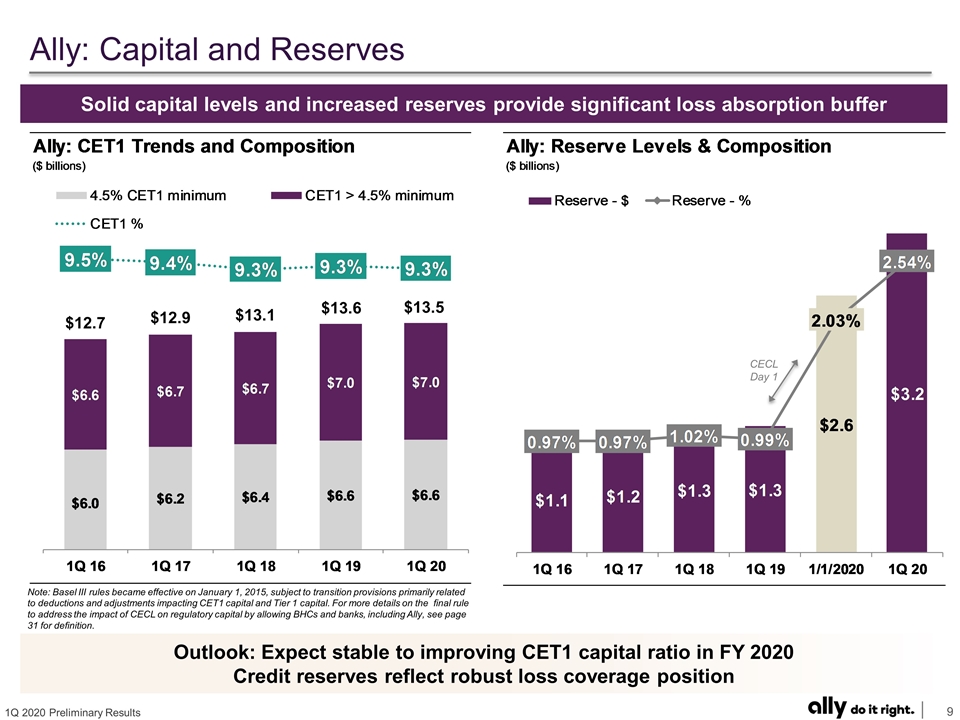
Ally: Capital and Reserves Solid capital levels and increased reserves provide significant loss absorption buffer $12.7 $12.9 $13.1 $13.6 $13.5 Outlook: Expect stable to improving CET1 capital ratio in FY 2020 Credit reserves reflect robust loss coverage position CECL Day 1 Note: Basel III rules became effective on January 1, 2015, subject to transition provisions primarily related to deductions and adjustments impacting CET1 capital and Tier 1 capital. For more details on the final rule to address the impact of CECL on regulatory capital by allowing BHCs and banks, including Ally, see page 31 for definition.
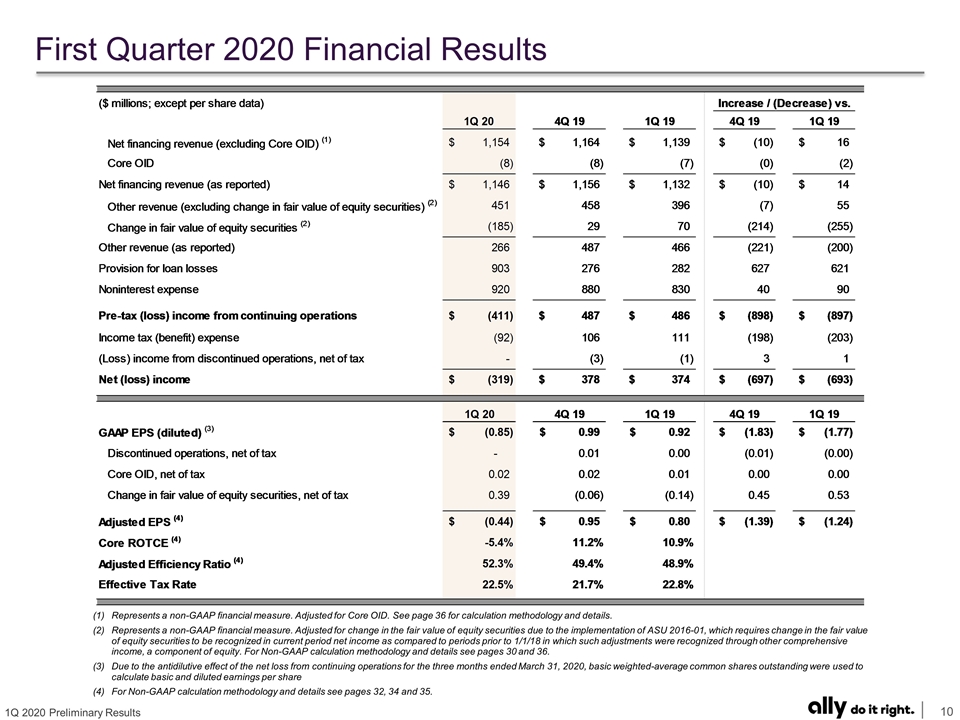
First Quarter 2020 Financial Results Represents a non-GAAP financial measure. Adjusted for Core OID. See page 36 for calculation methodology and details. Represents a non-GAAP financial measure. Adjusted for change in the fair value of equity securities due to the implementation of ASU 2016-01, which requires change in the fair value of equity securities to be recognized in current period net income as compared to periods prior to 1/1/18 in which such adjustments were recognized through other comprehensive income, a component of equity. For Non-GAAP calculation methodology and details see pages 30 and 36. Due to the antidilutive effect of the net loss from continuing operations for the three months ended March 31, 2020, basic weighted-average common shares outstanding were used to calculate basic and diluted earnings per share For Non-GAAP calculation methodology and details see pages 32, 34 and 35.
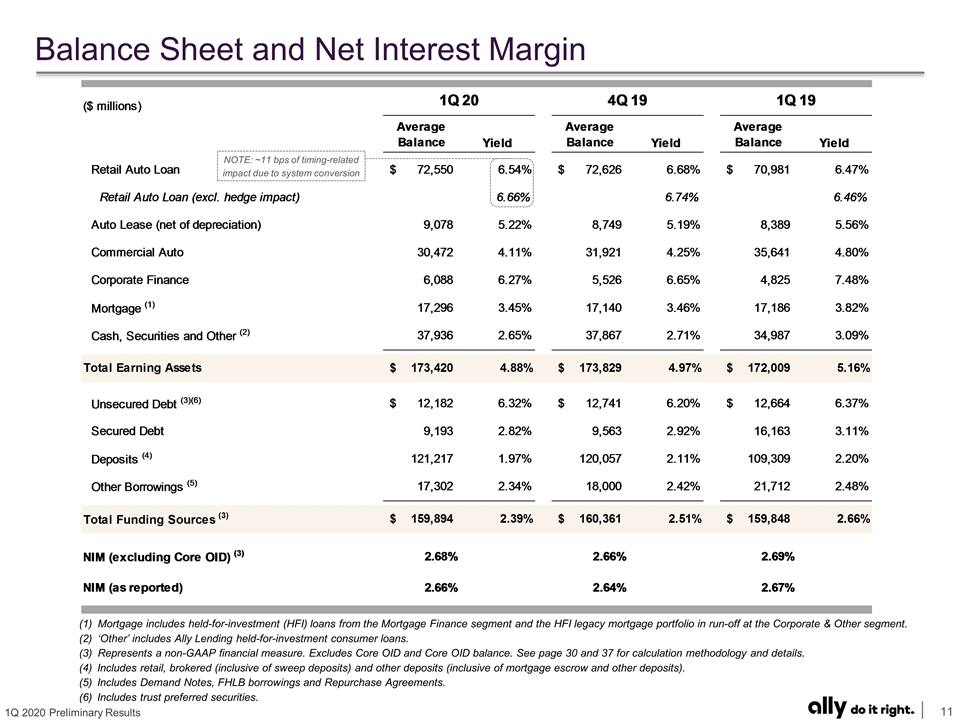
Balance Sheet and Net Interest Margin Mortgage includes held-for-investment (HFI) loans from the Mortgage Finance segment and the HFI legacy mortgage portfolio in run-off at the Corporate & Other segment. ‘Other’ includes Ally Lending held-for-investment consumer loans. Represents a non-GAAP financial measure. Excludes Core OID and Core OID balance. See page 30 and 37 for calculation methodology and details. Includes retail, brokered (inclusive of sweep deposits) and other deposits (inclusive of mortgage escrow and other deposits). Includes Demand Notes, FHLB borrowings and Repurchase Agreements. Includes trust preferred securities. NOTE: ~11 bps of timing-related impact due to system conversion
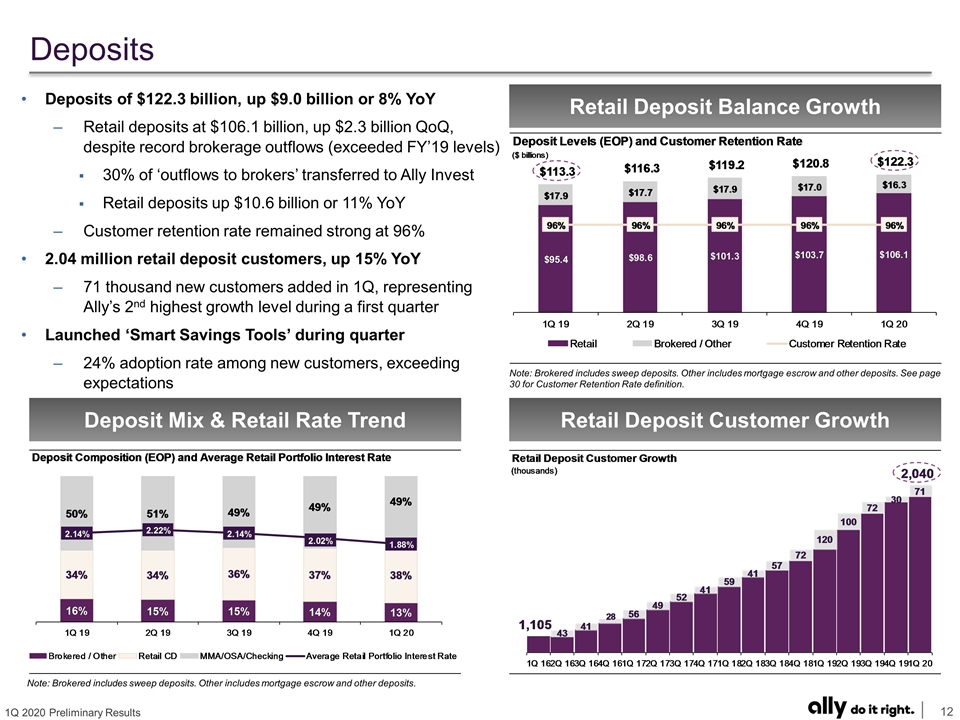
Retail Deposit Balance Growth Deposit Mix & Retail Rate Trend Retail Deposit Customer Growth Deposits Note: Brokered includes sweep deposits. Other includes mortgage escrow and other deposits. See page 30 for Customer Retention Rate definition. Deposits of $122.3 billion, up $9.0 billion or 8% YoY Retail deposits at $106.1 billion, up $2.3 billion QoQ, despite record brokerage outflows (exceeded FY’19 levels) 30% of ‘outflows to brokers’ transferred to Ally Invest Retail deposits up $10.6 billion or 11% YoY Customer retention rate remained strong at 96% 2.04 million retail deposit customers, up 15% YoY 71 thousand new customers added in 1Q, representing Ally’s 2nd highest growth level during a first quarter Launched ‘Smart Savings Tools’ during quarter 24% adoption rate among new customers, exceeding expectations Note: Brokered includes sweep deposits. Other includes mortgage escrow and other deposits.
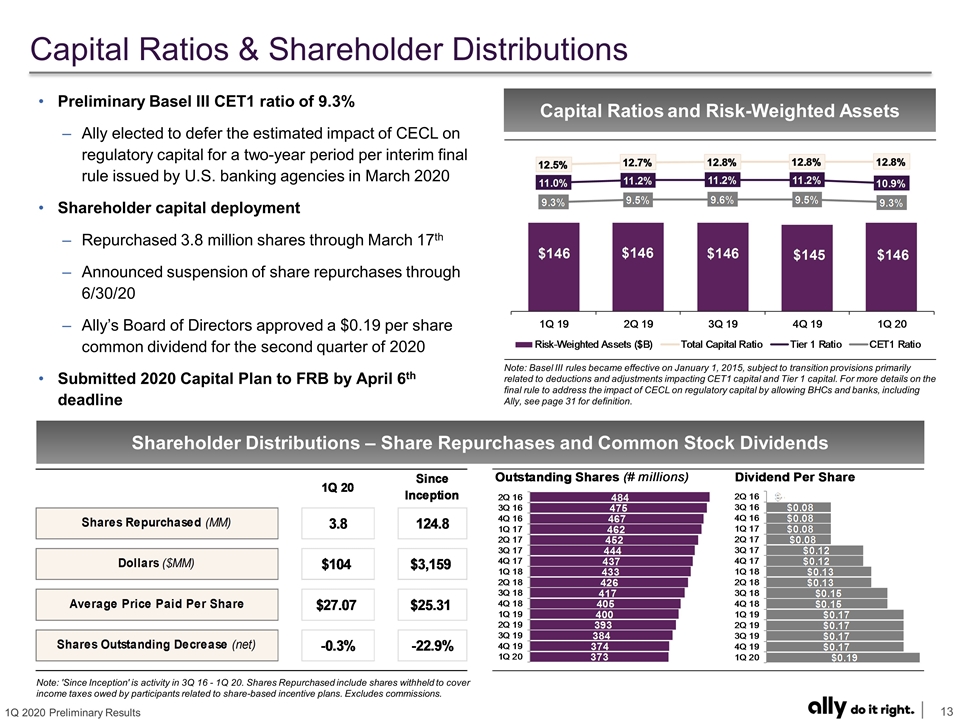
Capital Ratios and Risk-Weighted Assets Capital Ratios & Shareholder Distributions Preliminary Basel III CET1 ratio of 9.3% Ally elected to defer the estimated impact of CECL on regulatory capital for a two-year period per interim final rule issued by U.S. banking agencies in March 2020 Shareholder capital deployment Repurchased 3.8 million shares through March 17th Announced suspension of share repurchases through 6/30/20 Ally’s Board of Directors approved a $0.19 per share common dividend for the second quarter of 2020 Submitted 2020 Capital Plan to FRB by April 6th deadline Note: Basel III rules became effective on January 1, 2015, subject to transition provisions primarily related to deductions and adjustments impacting CET1 capital and Tier 1 capital. For more details on the final rule to address the impact of CECL on regulatory capital by allowing BHCs and banks, including Ally, see page 31 for definition. Note: 'Since Inception' is activity in 3Q 16 - 1Q 20. Shares Repurchased include shares withheld to cover income taxes owed by participants related to share-based incentive plans. Excludes commissions. Shareholder Distributions – Share Repurchases and Common Stock Dividends
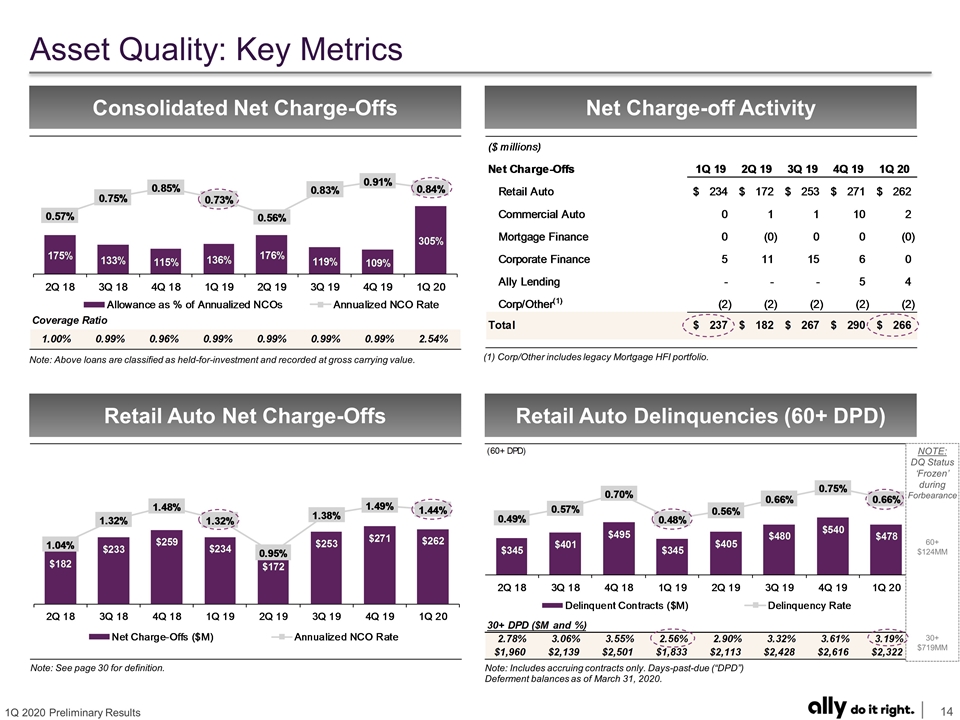
NOTE: DQ Status ‘Frozen’ during Forbearance Consolidated Net Charge-Offs Net Charge-off Activity Retail Auto Net Charge-Offs Retail Auto Delinquencies (60+ DPD) Asset Quality: Key Metrics Note: Above loans are classified as held-for-investment and recorded at gross carrying value. Note: Includes accruing contracts only. Days-past-due (“DPD”) Deferment balances as of March 31, 2020. (1) Corp/Other includes legacy Mortgage HFI portfolio. Note: See page 30 for definition. 60+ $124MM 30+ $719MM
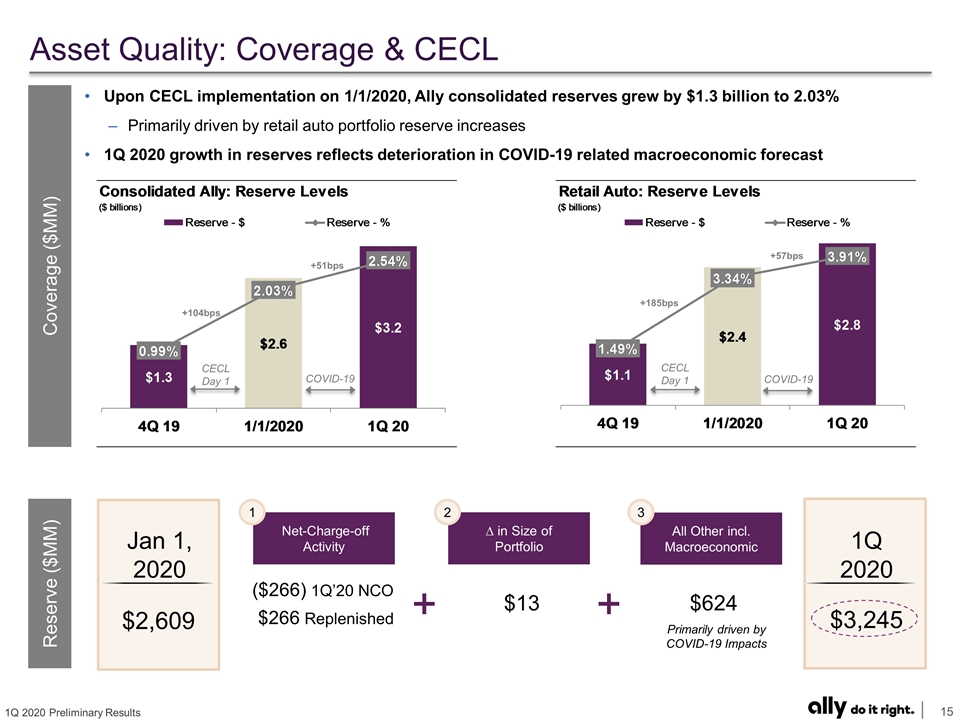
Asset Quality: Coverage & CECL Coverage ($MM) Reserve ($MM) Net-Charge-off Activity 1 ∆ in Size of Portfolio 2 All Other incl. Macroeconomic 3 Jan 1, 2020 $2,609 ($266) 1Q’20 NCO 1Q 2020 $3,245 $13 $624 Upon CECL implementation on 1/1/2020, Ally consolidated reserves grew by $1.3 billion to 2.03% Primarily driven by retail auto portfolio reserve increases 1Q 2020 growth in reserves reflects deterioration in COVID-19 related macroeconomic forecast $266 Replenished CECL Day 1 COVID-19 CECL Day 1 COVID-19 Primarily driven by COVID-19 Impacts +51bps +104bps +185bps +57bps
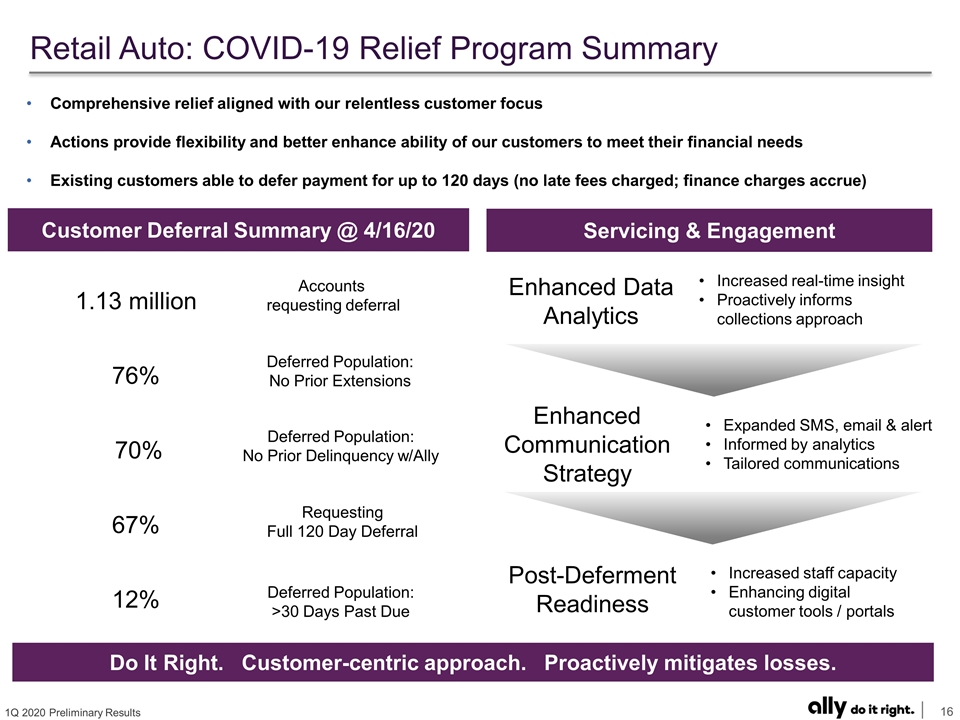
Retail Auto: COVID-19 Relief Program Summary Comprehensive relief aligned with our relentless customer focus Actions provide flexibility and better enhance ability of our customers to meet their financial needs Existing customers able to defer payment for up to 120 days (no late fees charged; finance charges accrue) Customer Deferral Summary @ 4/16/20 1.13 million Accounts requesting deferral 67% Requesting Full 120 Day Deferral 12% Deferred Population: >30 Days Past Due 76% Deferred Population: No Prior Extensions 70% Deferred Population: No Prior Delinquency w/Ally Servicing & Engagement Enhanced Data Analytics Increased real-time insight Proactively informs collections approach Enhanced Communication Strategy Expanded SMS, email & alert Informed by analytics Tailored communications Post-Deferment Readiness Increased staff capacity Enhancing digital customer tools / portals Do It Right. Customer-centric approach. Proactively mitigates losses.
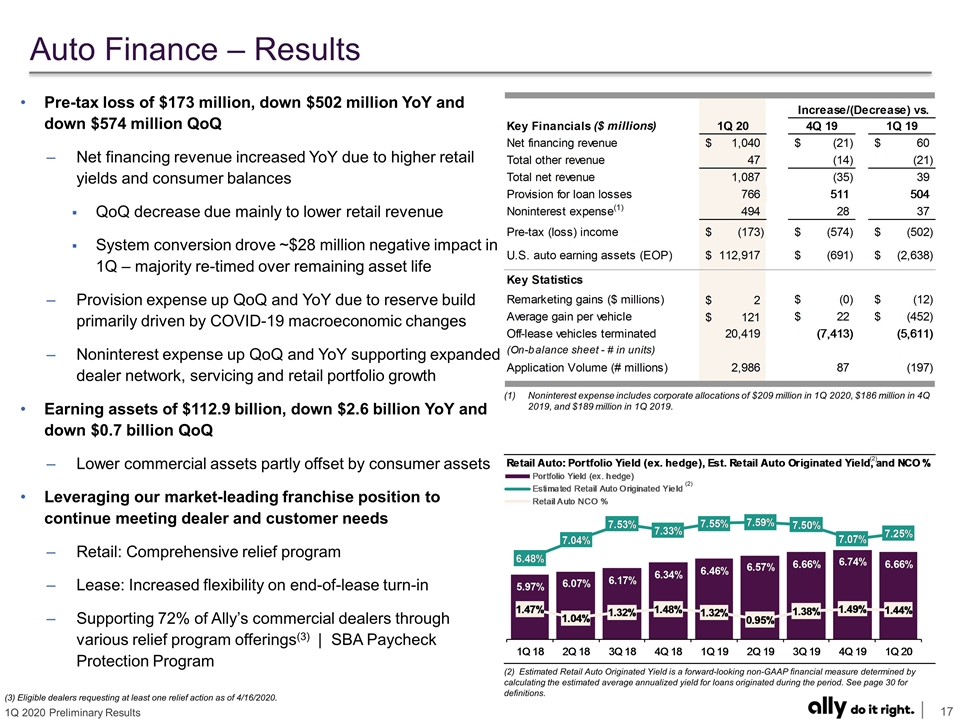
Auto Finance – Results Noninterest expense includes corporate allocations of $209 million in 1Q 2020, $186 million in 4Q 2019, and $189 million in 1Q 2019. Pre-tax loss of $173 million, down $502 million YoY and down $574 million QoQ Net financing revenue increased YoY due to higher retail yields and consumer balances QoQ decrease due mainly to lower retail revenue System conversion drove ~$28 million negative impact in 1Q – majority re-timed over remaining asset life Provision expense up QoQ and YoY due to reserve build primarily driven by COVID-19 macroeconomic changes Noninterest expense up QoQ and YoY supporting expanded dealer network, servicing and retail portfolio growth Earning assets of $112.9 billion, down $2.6 billion YoY and down $0.7 billion QoQ Lower commercial assets partly offset by consumer assets Leveraging our market-leading franchise position to continue meeting dealer and customer needs Retail: Comprehensive relief program Lease: Increased flexibility on end-of-lease turn-in Supporting 72% of Ally’s commercial dealers through various relief program offerings(3) | SBA Paycheck Protection Program (2) Estimated Retail Auto Originated Yield is a forward-looking non-GAAP financial measure determined by calculating the estimated average annualized yield for loans originated during the period. See page 30 for definitions. (2) (2) (3) Eligible dealers requesting at least one relief action as of 4/16/2020.
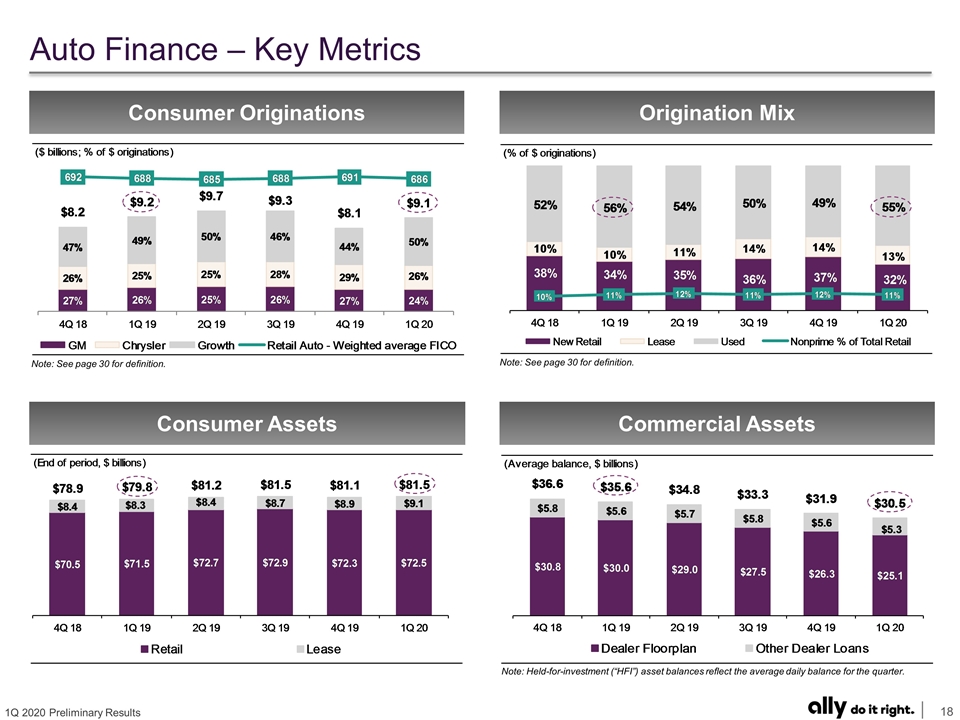
Consumer Originations Origination Mix Consumer Assets Commercial Assets Auto Finance – Key Metrics Note: Held-for-investment (“HFI”) asset balances reflect the average daily balance for the quarter. Note: See page 30 for definition. Note: See page 30 for definition.
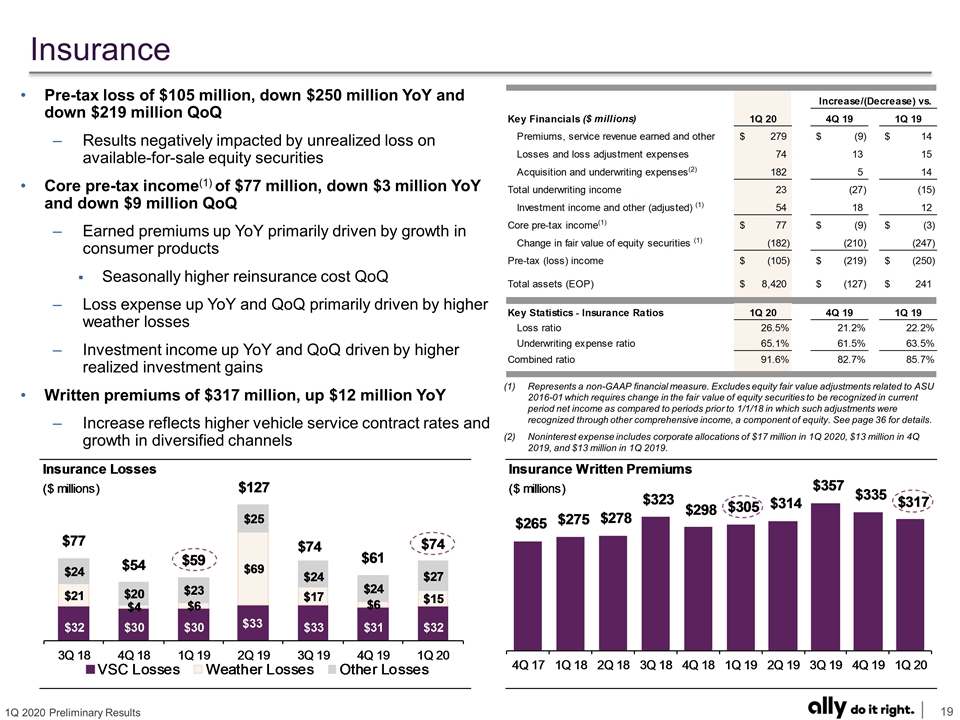
Insurance Represents a non-GAAP financial measure. Excludes equity fair value adjustments related to ASU 2016-01 which requires change in the fair value of equity securities to be recognized in current period net income as compared to periods prior to 1/1/18 in which such adjustments were recognized through other comprehensive income, a component of equity. See page 36 for details. Noninterest expense includes corporate allocations of $17 million in 1Q 2020, $13 million in 4Q 2019, and $13 million in 1Q 2019. Pre-tax loss of $105 million, down $250 million YoY and down $219 million QoQ Results negatively impacted by unrealized loss on available-for-sale equity securities Core pre-tax income(1) of $77 million, down $3 million YoY and down $9 million QoQ Earned premiums up YoY primarily driven by growth in consumer products Seasonally higher reinsurance cost QoQ Loss expense up YoY and QoQ primarily driven by higher weather losses Investment income up YoY and QoQ driven by higher realized investment gains Written premiums of $317 million, up $12 million YoY Increase reflects higher vehicle service contract rates and growth in diversified channels
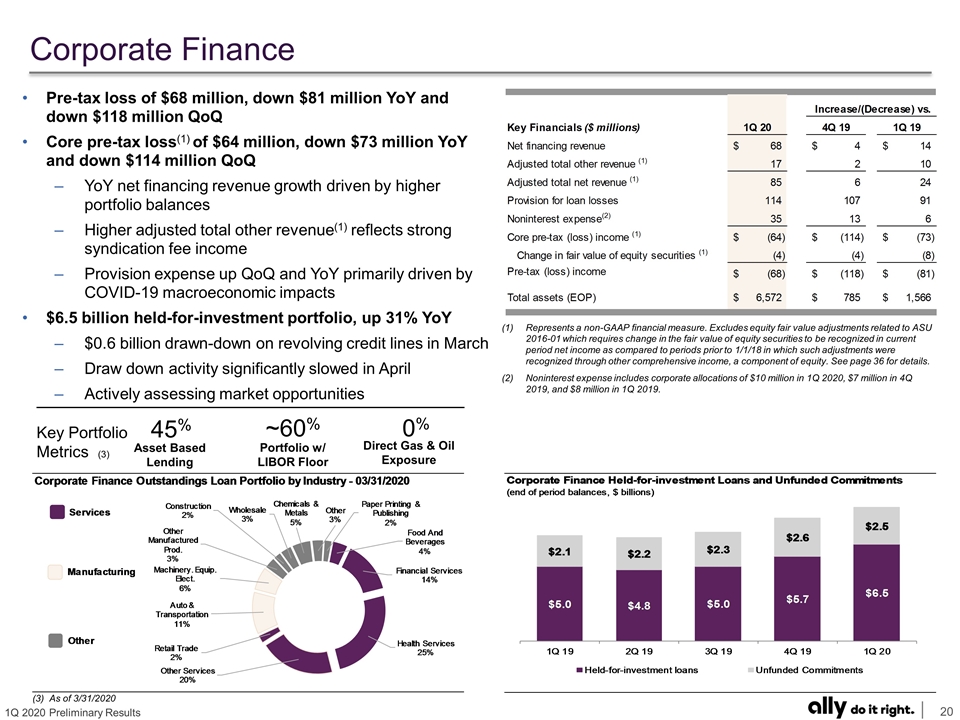
Corporate Finance Represents a non-GAAP financial measure. Excludes equity fair value adjustments related to ASU 2016-01 which requires change in the fair value of equity securities to be recognized in current period net income as compared to periods prior to 1/1/18 in which such adjustments were recognized through other comprehensive income, a component of equity. See page 36 for details. Noninterest expense includes corporate allocations of $10 million in 1Q 2020, $7 million in 4Q 2019, and $8 million in 1Q 2019. Pre-tax loss of $68 million, down $81 million YoY and down $118 million QoQ Core pre-tax loss(1) of $64 million, down $73 million YoY and down $114 million QoQ YoY net financing revenue growth driven by higher portfolio balances Higher adjusted total other revenue(1) reflects strong syndication fee income Provision expense up QoQ and YoY primarily driven by COVID-19 macroeconomic impacts $6.5 billion held-for-investment portfolio, up 31% YoY $0.6 billion drawn-down on revolving credit lines in March Draw down activity significantly slowed in April Actively assessing market opportunities Asset Based Lending 45% ~60% 0% Portfolio w/ LIBOR Floor Direct Gas & Oil Exposure Key Portfolio Metrics (3) (3) As of 3/31/2020
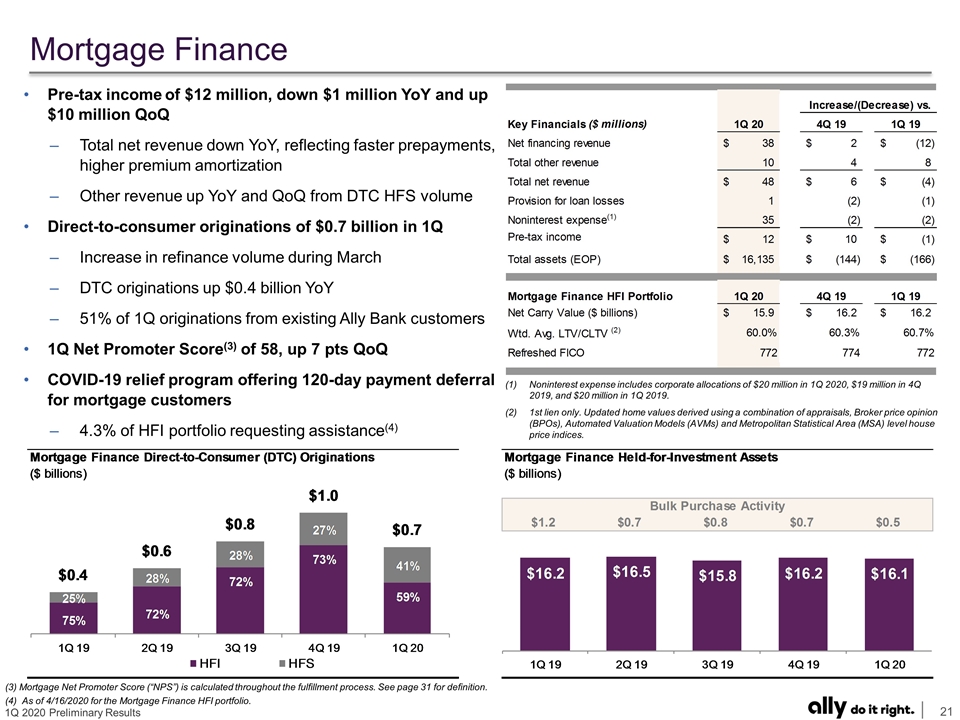
Mortgage Finance Noninterest expense includes corporate allocations of $20 million in 1Q 2020, $19 million in 4Q 2019, and $20 million in 1Q 2019. 1st lien only. Updated home values derived using a combination of appraisals, Broker price opinion (BPOs), Automated Valuation Models (AVMs) and Metropolitan Statistical Area (MSA) level house price indices. Pre-tax income of $12 million, down $1 million YoY and up $10 million QoQ Total net revenue down YoY, reflecting faster prepayments, higher premium amortization Other revenue up YoY and QoQ from DTC HFS volume Direct-to-consumer originations of $0.7 billion in 1Q Increase in refinance volume during March DTC originations up $0.4 billion YoY 51% of 1Q originations from existing Ally Bank customers 1Q Net Promoter Score(3) of 58, up 7 pts QoQ COVID-19 relief program offering 120-day payment deferral for mortgage customers 4.3% of HFI portfolio requesting assistance(4) (3) Mortgage Net Promoter Score (“NPS”) is calculated throughout the fulfillment process. See page 31 for definition. (4) As of 4/16/2020 for the Mortgage Finance HFI portfolio.
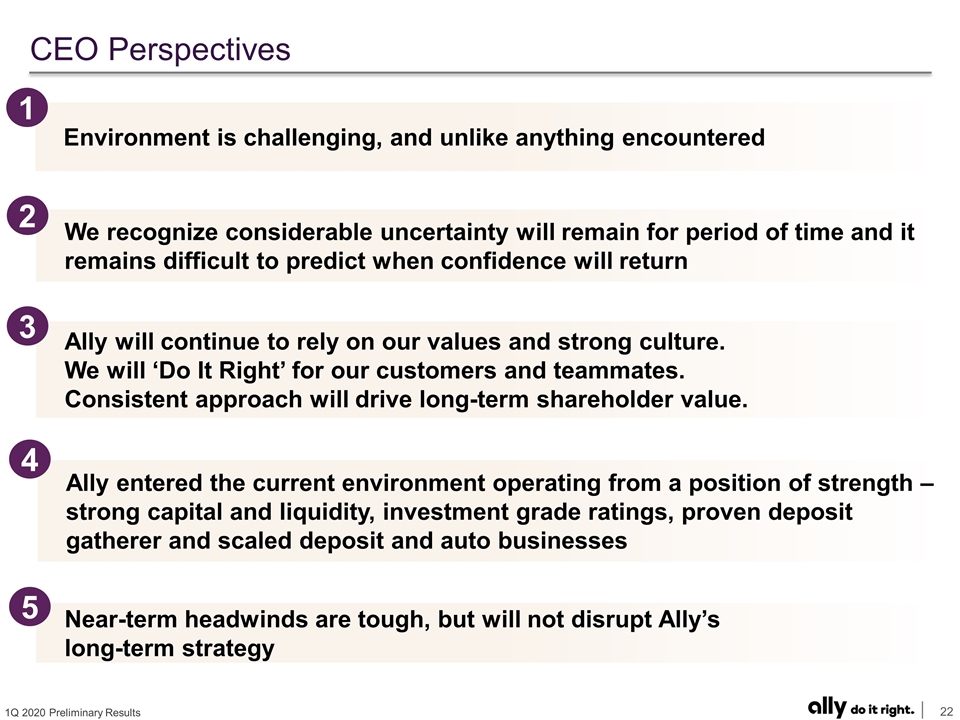
Near-term headwinds are tough, but will not disrupt Ally’s long-term strategy We recognize considerable uncertainty will remain for period of time and it remains difficult to predict when confidence will return Environment is challenging, and unlike anything encountered CEO Perspectives 1 Ally entered the current environment operating from a position of strength – strong capital and liquidity, investment grade ratings, proven deposit gatherer and scaled deposit and auto businesses 2 4 5 Ally will continue to rely on our values and strong culture. We will ‘Do It Right’ for our customers and teammates. Consistent approach will drive long-term shareholder value. 3
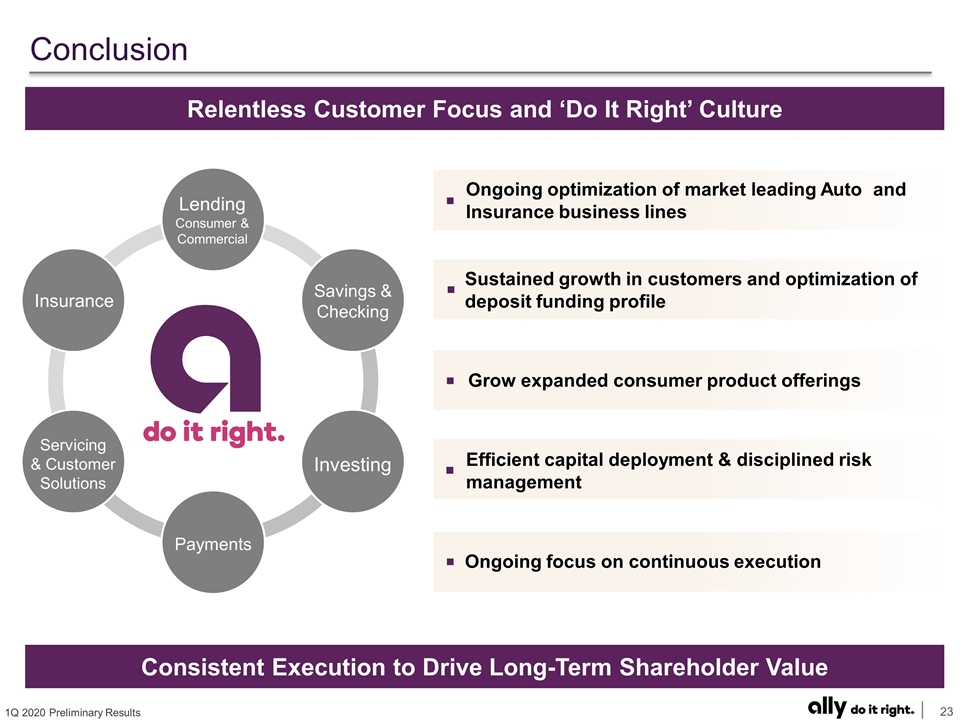
Conclusion Relentless Customer Focus and ‘Do It Right’ Culture Consistent Execution to Drive Long-Term Shareholder Value Ongoing optimization of market leading Auto and Insurance business lines Sustained growth in customers and optimization of deposit funding profile Grow expanded consumer product offerings Efficient capital deployment & disciplined risk management Ongoing focus on continuous execution Servicing & Customer Solutions Payments Investing Savings & Checking Lending Consumer & Commercial Insurance
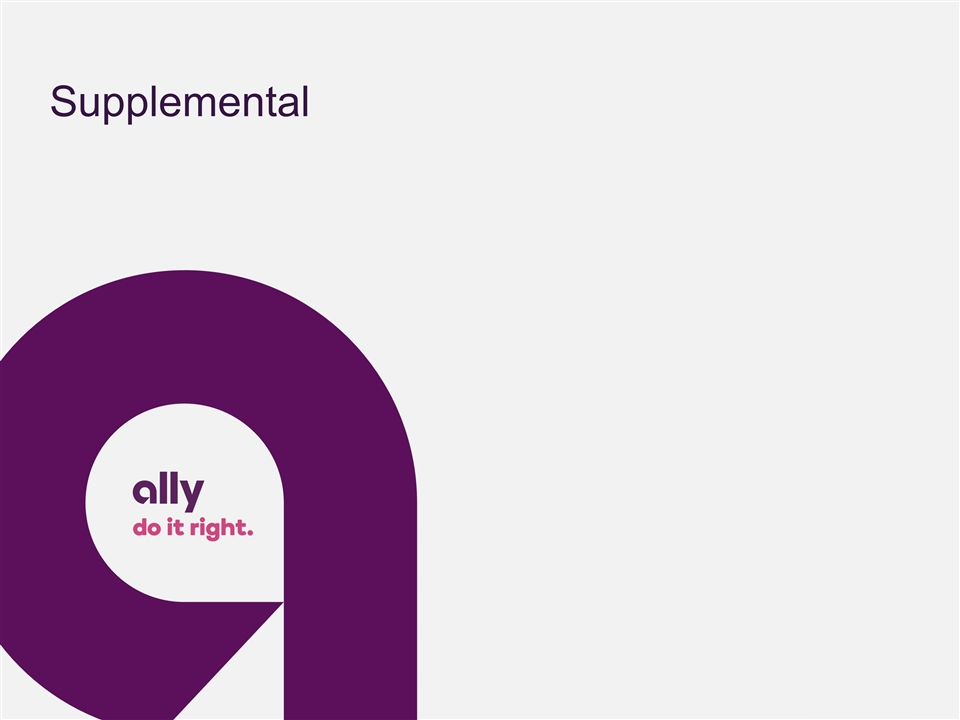
Supplemental
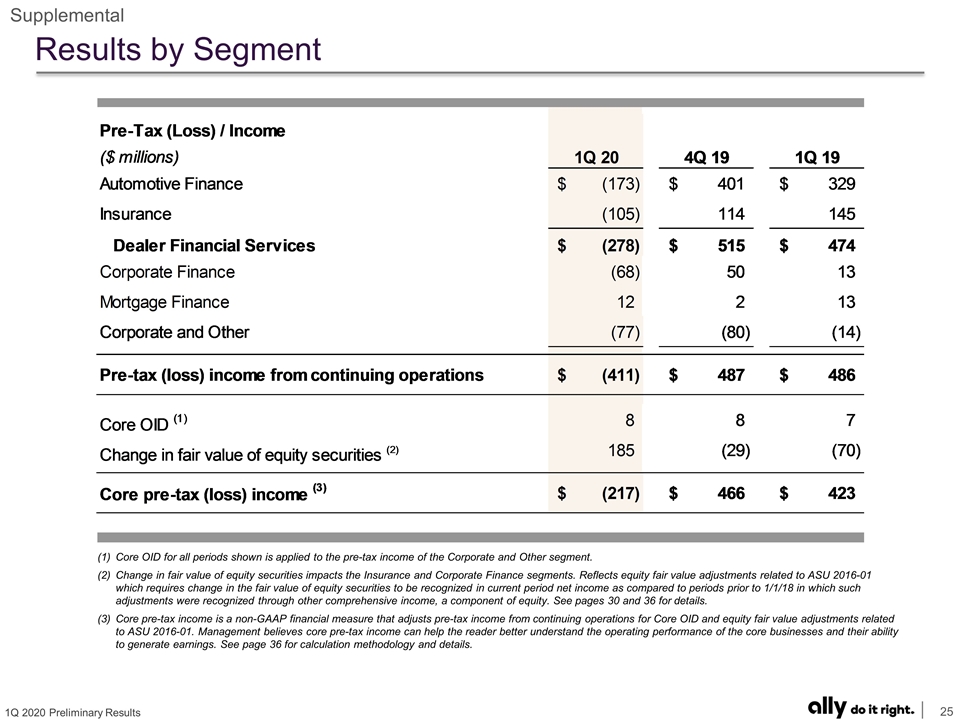
Results by Segment Core OID for all periods shown is applied to the pre-tax income of the Corporate and Other segment. Change in fair value of equity securities impacts the Insurance and Corporate Finance segments. Reflects equity fair value adjustments related to ASU 2016-01 which requires change in the fair value of equity securities to be recognized in current period net income as compared to periods prior to 1/1/18 in which such adjustments were recognized through other comprehensive income, a component of equity. See pages 30 and 36 for details. Core pre-tax income is a non-GAAP financial measure that adjusts pre-tax income from continuing operations for Core OID and equity fair value adjustments related to ASU 2016-01. Management believes core pre-tax income can help the reader better understand the operating performance of the core businesses and their ability to generate earnings. See page 36 for calculation methodology and details. Supplemental
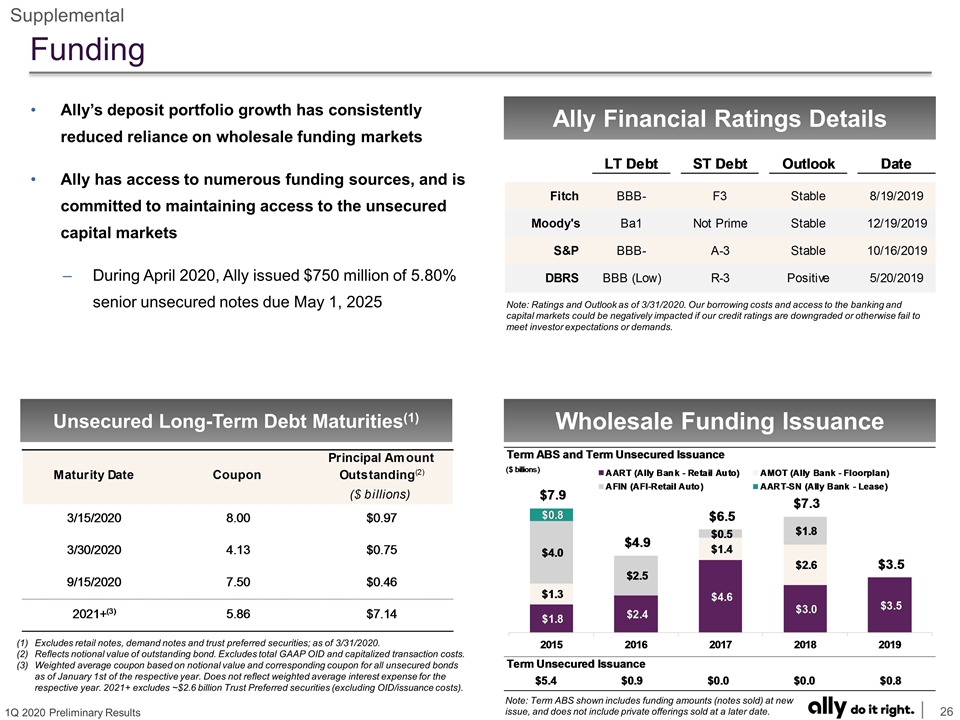
Unsecured Long-Term Debt Maturities(1) Funding Ally’s deposit portfolio growth has consistently reduced reliance on wholesale funding markets Ally has access to numerous funding sources, and is committed to maintaining access to the unsecured capital markets During April 2020, Ally issued $750 million of 5.80% senior unsecured notes due May 1, 2025 Supplemental Excludes retail notes, demand notes and trust preferred securities; as of 3/31/2020. Reflects notional value of outstanding bond. Excludes total GAAP OID and capitalized transaction costs. Weighted average coupon based on notional value and corresponding coupon for all unsecured bonds as of January 1st of the respective year. Does not reflect weighted average interest expense for the respective year. 2021+ excludes ~$2.6 billion Trust Preferred securities (excluding OID/issuance costs). Wholesale Funding Issuance Ally Financial Ratings Details Note: Ratings and Outlook as of 3/31/2020. Our borrowing costs and access to the banking and capital markets could be negatively impacted if our credit ratings are downgraded or otherwise fail to meet investor expectations or demands. Note: Term ABS shown includes funding amounts (notes sold) at new issue, and does not include private offerings sold at a later date.

Corporate and Other Represents a non-GAAP financial measure. See page 37 for details. Represents a non-GAAP financial measure. See page 36 for calculation methodology and details. HFI legacy mortgage portfolio and HFI Ally Lending portfolio Corporate and Other includes the impact of centralized asset and liability management, corporate overhead allocation activities, the legacy mortgage portfolio, Ally Invest activity and Ally Lending activity Pre-tax loss of $77 million, down $63 million YoY and up $3 million QoQ Net financing loss down YoY primarily driven by lower yields on cash and investment securities, and hedge activity Total other revenue up YoY primarily driven by gains on investment securities Provision expense up QoQ and YoY due to reserve build primarily driven by COVID-19 macroeconomic changes at Ally Lending Noninterest expense up YoY primarily driven by addition of Ally Lending in 4Q 19 and technology spend supporting business initiatives Total assets of $39.8 billion, up $5.0 billion YoY Higher cash and investment securities balance and addition of Ally Lending portfolio COVID-19 Relief Program includes 120-day payment deferral for customers at Ally Lending 4.0% of active accounts(4) Supplemental (4) As of 4/16/2020.
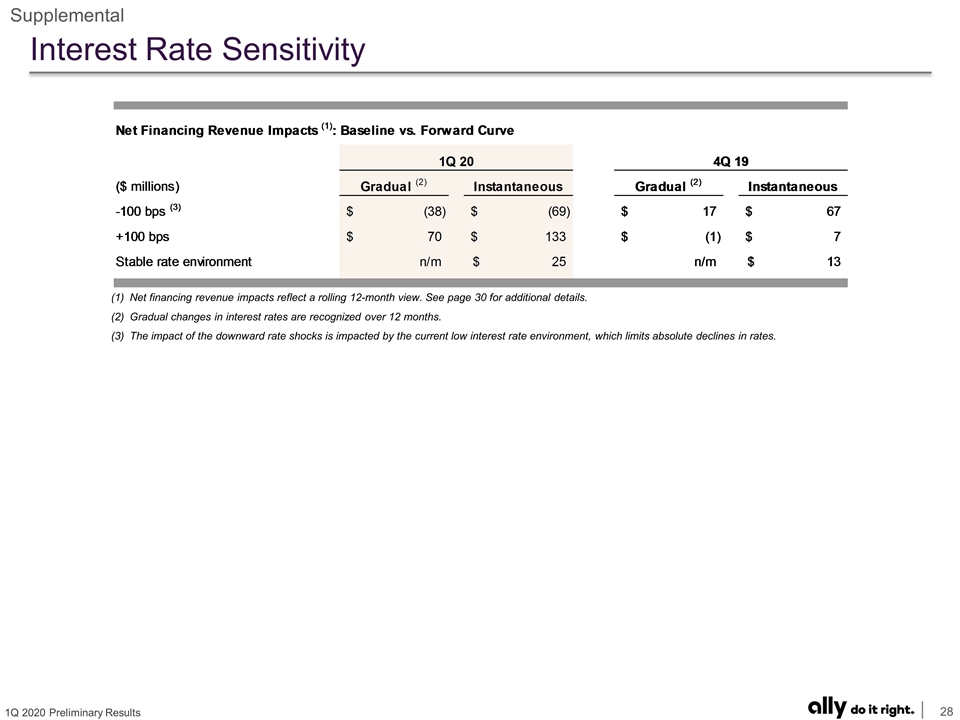
Interest Rate Sensitivity Supplemental Net financing revenue impacts reflect a rolling 12-month view. See page 30 for additional details. Gradual changes in interest rates are recognized over 12 months. The impact of the downward rate shocks is impacted by the current low interest rate environment, which limits absolute declines in rates.
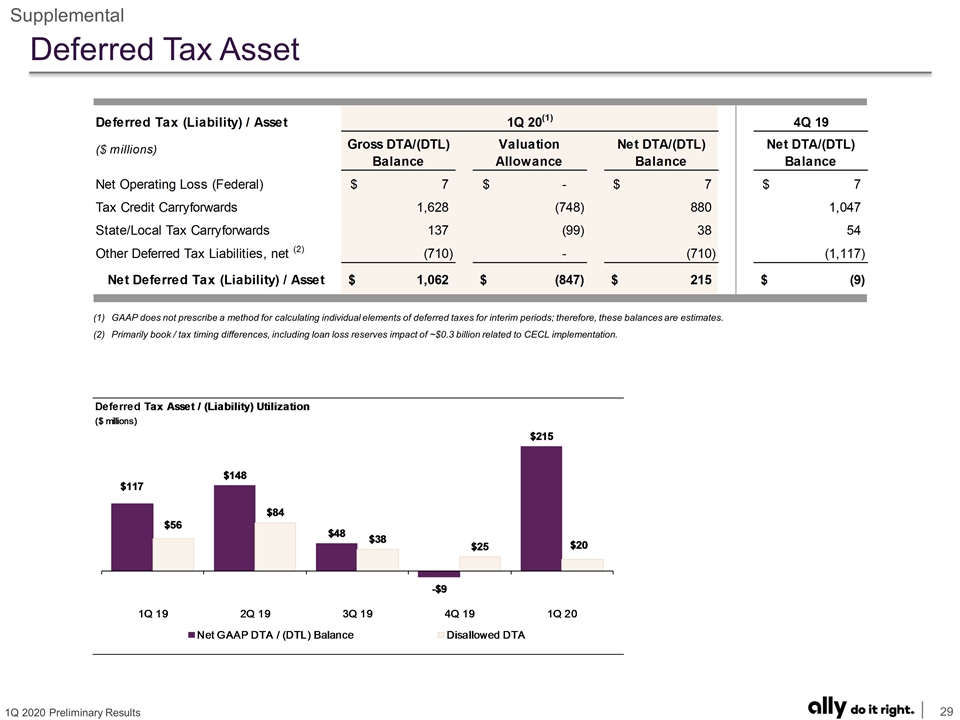
GAAP does not prescribe a method for calculating individual elements of deferred taxes for interim periods; therefore, these balances are estimates. Primarily book / tax timing differences, including loan loss reserves impact of ~$0.3 billion related to CECL implementation. Deferred Tax Asset Supplemental
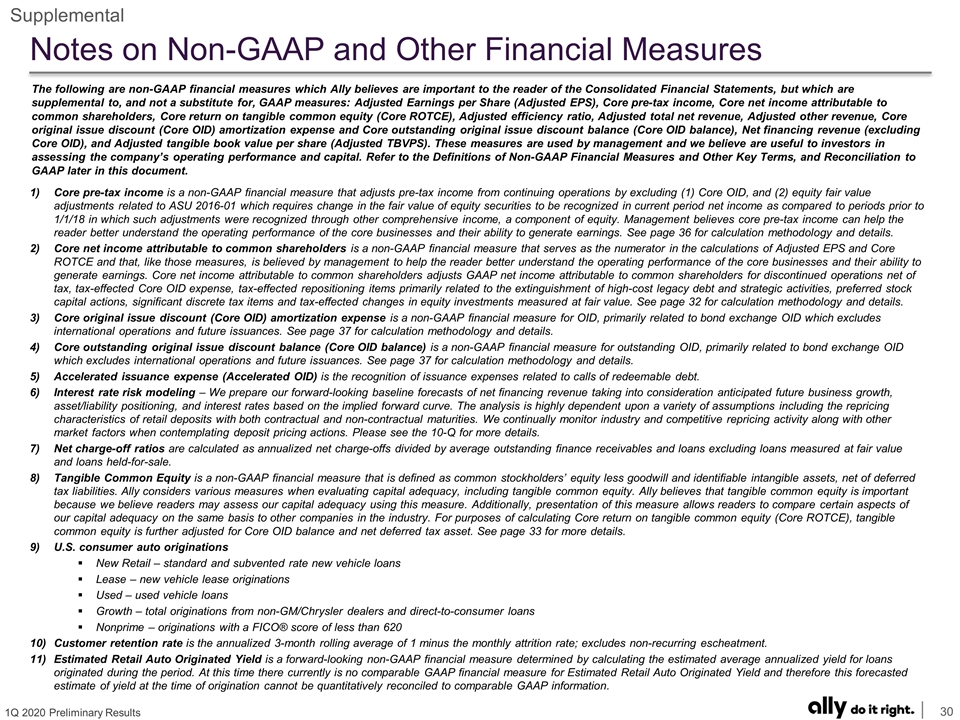
Notes on Non-GAAP and Other Financial Measures Supplemental Core pre-tax income is a non-GAAP financial measure that adjusts pre-tax income from continuing operations by excluding (1) Core OID, and (2) equity fair value adjustments related to ASU 2016-01 which requires change in the fair value of equity securities to be recognized in current period net income as compared to periods prior to 1/1/18 in which such adjustments were recognized through other comprehensive income, a component of equity. Management believes core pre-tax income can help the reader better understand the operating performance of the core businesses and their ability to generate earnings. See page 36 for calculation methodology and details. Core net income attributable to common shareholders is a non-GAAP financial measure that serves as the numerator in the calculations of Adjusted EPS and Core ROTCE and that, like those measures, is believed by management to help the reader better understand the operating performance of the core businesses and their ability to generate earnings. Core net income attributable to common shareholders adjusts GAAP net income attributable to common shareholders for discontinued operations net of tax, tax-effected Core OID expense, tax-effected repositioning items primarily related to the extinguishment of high-cost legacy debt and strategic activities, preferred stock capital actions, significant discrete tax items and tax-effected changes in equity investments measured at fair value. See page 32 for calculation methodology and details. Core original issue discount (Core OID) amortization expense is a non-GAAP financial measure for OID, primarily related to bond exchange OID which excludes international operations and future issuances. See page 37 for calculation methodology and details. Core outstanding original issue discount balance (Core OID balance) is a non-GAAP financial measure for outstanding OID, primarily related to bond exchange OID which excludes international operations and future issuances. See page 37 for calculation methodology and details. Accelerated issuance expense (Accelerated OID) is the recognition of issuance expenses related to calls of redeemable debt. Interest rate risk modeling – We prepare our forward-looking baseline forecasts of net financing revenue taking into consideration anticipated future business growth, asset/liability positioning, and interest rates based on the implied forward curve. The analysis is highly dependent upon a variety of assumptions including the repricing characteristics of retail deposits with both contractual and non-contractual maturities. We continually monitor industry and competitive repricing activity along with other market factors when contemplating deposit pricing actions. Please see the 10-Q for more details. Net charge-off ratios are calculated as annualized net charge-offs divided by average outstanding finance receivables and loans excluding loans measured at fair value and loans held-for-sale. Tangible Common Equity is a non-GAAP financial measure that is defined as common stockholders’ equity less goodwill and identifiable intangible assets, net of deferred tax liabilities. Ally considers various measures when evaluating capital adequacy, including tangible common equity. Ally believes that tangible common equity is important because we believe readers may assess our capital adequacy using this measure. Additionally, presentation of this measure allows readers to compare certain aspects of our capital adequacy on the same basis to other companies in the industry. For purposes of calculating Core return on tangible common equity (Core ROTCE), tangible common equity is further adjusted for Core OID balance and net deferred tax asset. See page 33 for more details. U.S. consumer auto originations New Retail – standard and subvented rate new vehicle loans Lease – new vehicle lease originations Used – used vehicle loans Growth – total originations from non-GM/Chrysler dealers and direct-to-consumer loans Nonprime – originations with a FICO® score of less than 620 Customer retention rate is the annualized 3-month rolling average of 1 minus the monthly attrition rate; excludes non-recurring escheatment. Estimated Retail Auto Originated Yield is a forward-looking non-GAAP financial measure determined by calculating the estimated average annualized yield for loans originated during the period. At this time there currently is no comparable GAAP financial measure for Estimated Retail Auto Originated Yield and therefore this forecasted estimate of yield at the time of origination cannot be quantitatively reconciled to comparable GAAP information. The following are non-GAAP financial measures which Ally believes are important to the reader of the Consolidated Financial Statements, but which are supplemental to, and not a substitute for, GAAP measures: Adjusted Earnings per Share (Adjusted EPS), Core pre-tax income, Core net income attributable to common shareholders, Core return on tangible common equity (Core ROTCE), Adjusted efficiency ratio, Adjusted total net revenue, Adjusted other revenue, Core original issue discount (Core OID) amortization expense and Core outstanding original issue discount balance (Core OID balance), Net financing revenue (excluding Core OID), and Adjusted tangible book value per share (Adjusted TBVPS). These measures are used by management and we believe are useful to investors in assessing the company’s operating performance and capital. Refer to the Definitions of Non-GAAP Financial Measures and Other Key Terms, and Reconciliation to GAAP later in this document.
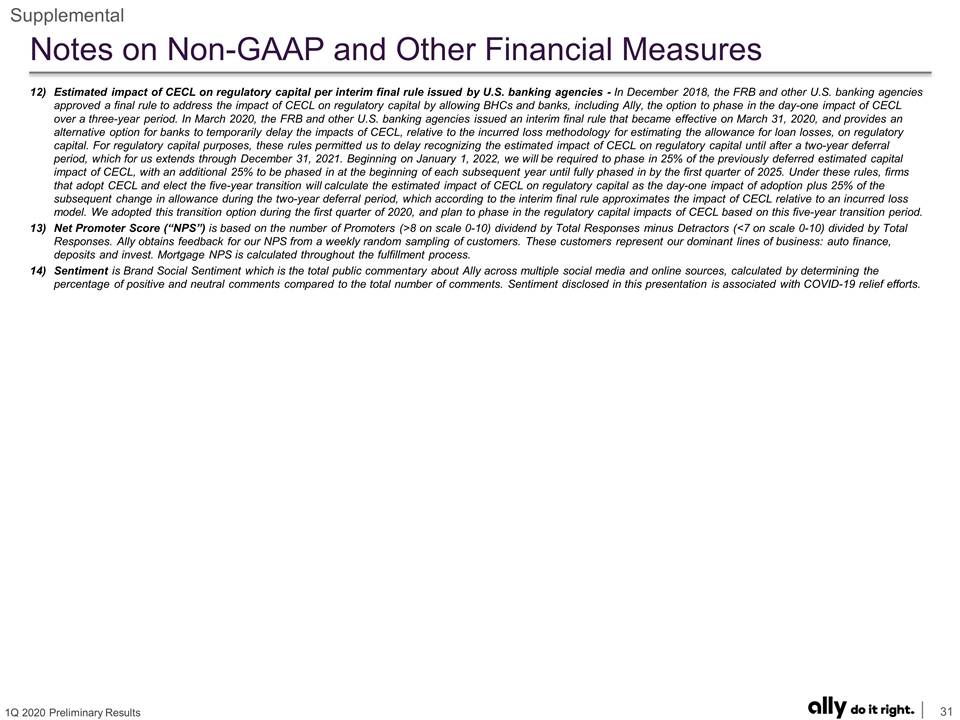
Notes on Non-GAAP and Other Financial Measures Supplemental Estimated impact of CECL on regulatory capital per interim final rule issued by U.S. banking agencies - In December 2018, the FRB and other U.S. banking agencies approved a final rule to address the impact of CECL on regulatory capital by allowing BHCs and banks, including Ally, the option to phase in the day-one impact of CECL over a three-year period. In March 2020, the FRB and other U.S. banking agencies issued an interim final rule that became effective on March 31, 2020, and provides an alternative option for banks to temporarily delay the impacts of CECL, relative to the incurred loss methodology for estimating the allowance for loan losses, on regulatory capital. For regulatory capital purposes, these rules permitted us to delay recognizing the estimated impact of CECL on regulatory capital until after a two-year deferral period, which for us extends through December 31, 2021. Beginning on January 1, 2022, we will be required to phase in 25% of the previously deferred estimated capital impact of CECL, with an additional 25% to be phased in at the beginning of each subsequent year until fully phased in by the first quarter of 2025. Under these rules, firms that adopt CECL and elect the five-year transition will calculate the estimated impact of CECL on regulatory capital as the day-one impact of adoption plus 25% of the subsequent change in allowance during the two-year deferral period, which according to the interim final rule approximates the impact of CECL relative to an incurred loss model. We adopted this transition option during the first quarter of 2020, and plan to phase in the regulatory capital impacts of CECL based on this five-year transition period. Net Promoter Score (“NPS”) is based on the number of Promoters (>8 on scale 0-10) dividend by Total Responses minus Detractors (<7 on scale 0-10) divided by Total Responses. Ally obtains feedback for our NPS from a weekly random sampling of customers. These customers represent our dominant lines of business: auto finance, deposits and invest. Mortgage NPS is calculated throughout the fulfillment process. Sentiment is Brand Social Sentiment which is the total public commentary about Ally across multiple social media and online sources, calculated by determining the percentage of positive and neutral comments compared to the total number of comments. Sentiment disclosed in this presentation is associated with COVID-19 relief efforts.
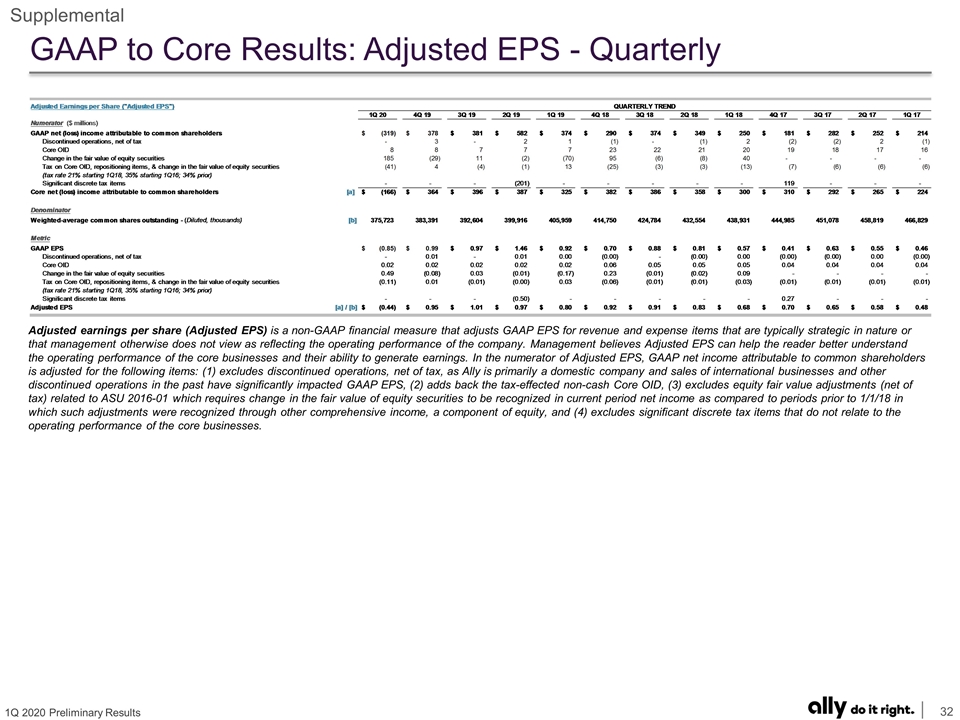
GAAP to Core Results: Adjusted EPS - Quarterly Supplemental Adjusted earnings per share (Adjusted EPS) is a non-GAAP financial measure that adjusts GAAP EPS for revenue and expense items that are typically strategic in nature or that management otherwise does not view as reflecting the operating performance of the company. Management believes Adjusted EPS can help the reader better understand the operating performance of the core businesses and their ability to generate earnings. In the numerator of Adjusted EPS, GAAP net income attributable to common shareholders is adjusted for the following items: (1) excludes discontinued operations, net of tax, as Ally is primarily a domestic company and sales of international businesses and other discontinued operations in the past have significantly impacted GAAP EPS, (2) adds back the tax-effected non-cash Core OID, (3) excludes equity fair value adjustments (net of tax) related to ASU 2016-01 which requires change in the fair value of equity securities to be recognized in current period net income as compared to periods prior to 1/1/18 in which such adjustments were recognized through other comprehensive income, a component of equity, and (4) excludes significant discrete tax items that do not relate to the operating performance of the core businesses.
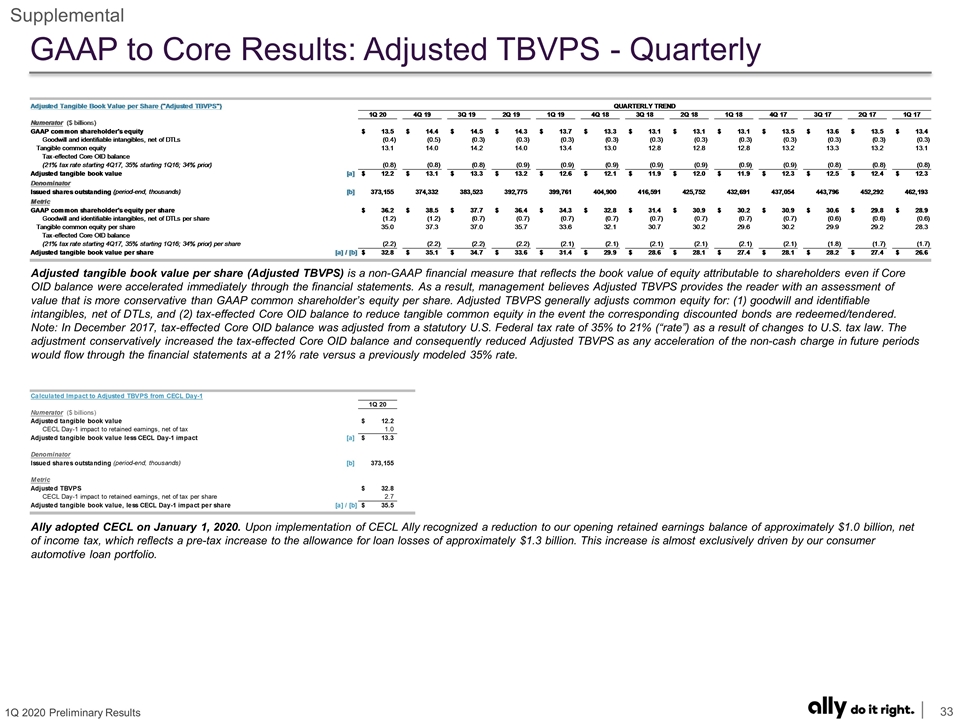
GAAP to Core Results: Adjusted TBVPS - Quarterly Supplemental Adjusted tangible book value per share (Adjusted TBVPS) is a non-GAAP financial measure that reflects the book value of equity attributable to shareholders even if Core OID balance were accelerated immediately through the financial statements. As a result, management believes Adjusted TBVPS provides the reader with an assessment of value that is more conservative than GAAP common shareholder’s equity per share. Adjusted TBVPS generally adjusts common equity for: (1) goodwill and identifiable intangibles, net of DTLs, and (2) tax-effected Core OID balance to reduce tangible common equity in the event the corresponding discounted bonds are redeemed/tendered. Note: In December 2017, tax-effected Core OID balance was adjusted from a statutory U.S. Federal tax rate of 35% to 21% (“rate”) as a result of changes to U.S. tax law. The adjustment conservatively increased the tax-effected Core OID balance and consequently reduced Adjusted TBVPS as any acceleration of the non-cash charge in future periods would flow through the financial statements at a 21% rate versus a previously modeled 35% rate. Ally adopted CECL on January 1, 2020. Upon implementation of CECL Ally recognized a reduction to our opening retained earnings balance of approximately $1.0 billion, net of income tax, which reflects a pre-tax increase to the allowance for loan losses of approximately $1.3 billion. This increase is almost exclusively driven by our consumer automotive loan portfolio.
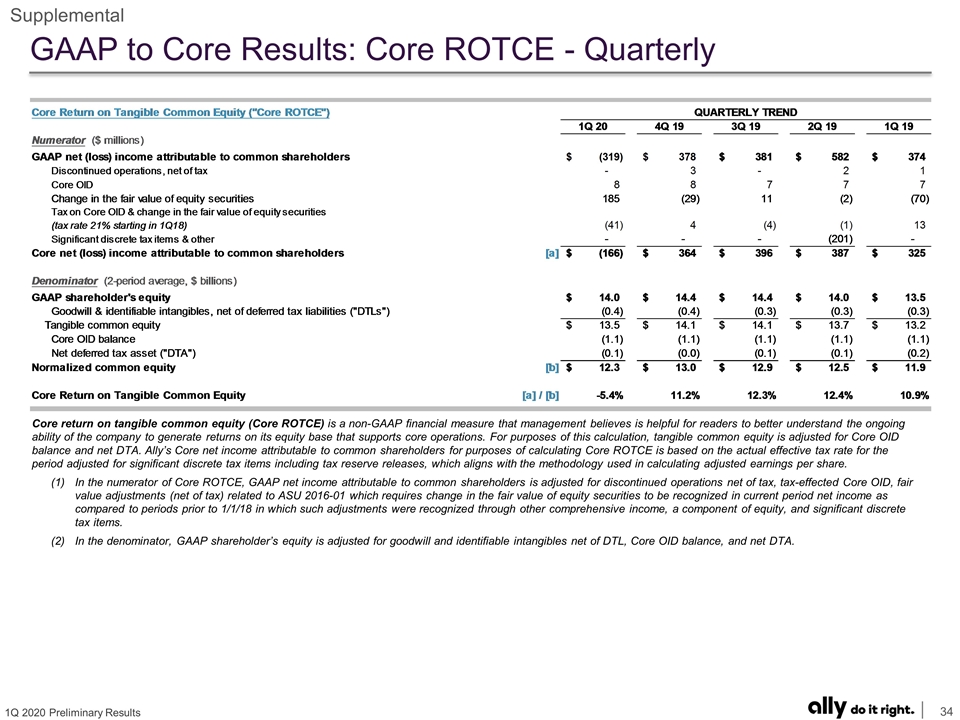
GAAP to Core Results: Core ROTCE - Quarterly Supplemental Core return on tangible common equity (Core ROTCE) is a non-GAAP financial measure that management believes is helpful for readers to better understand the ongoing ability of the company to generate returns on its equity base that supports core operations. For purposes of this calculation, tangible common equity is adjusted for Core OID balance and net DTA. Ally’s Core net income attributable to common shareholders for purposes of calculating Core ROTCE is based on the actual effective tax rate for the period adjusted for significant discrete tax items including tax reserve releases, which aligns with the methodology used in calculating adjusted earnings per share. In the numerator of Core ROTCE, GAAP net income attributable to common shareholders is adjusted for discontinued operations net of tax, tax-effected Core OID, fair value adjustments (net of tax) related to ASU 2016-01 which requires change in the fair value of equity securities to be recognized in current period net income as compared to periods prior to 1/1/18 in which such adjustments were recognized through other comprehensive income, a component of equity, and significant discrete tax items. In the denominator, GAAP shareholder’s equity is adjusted for goodwill and identifiable intangibles net of DTL, Core OID balance, and net DTA.
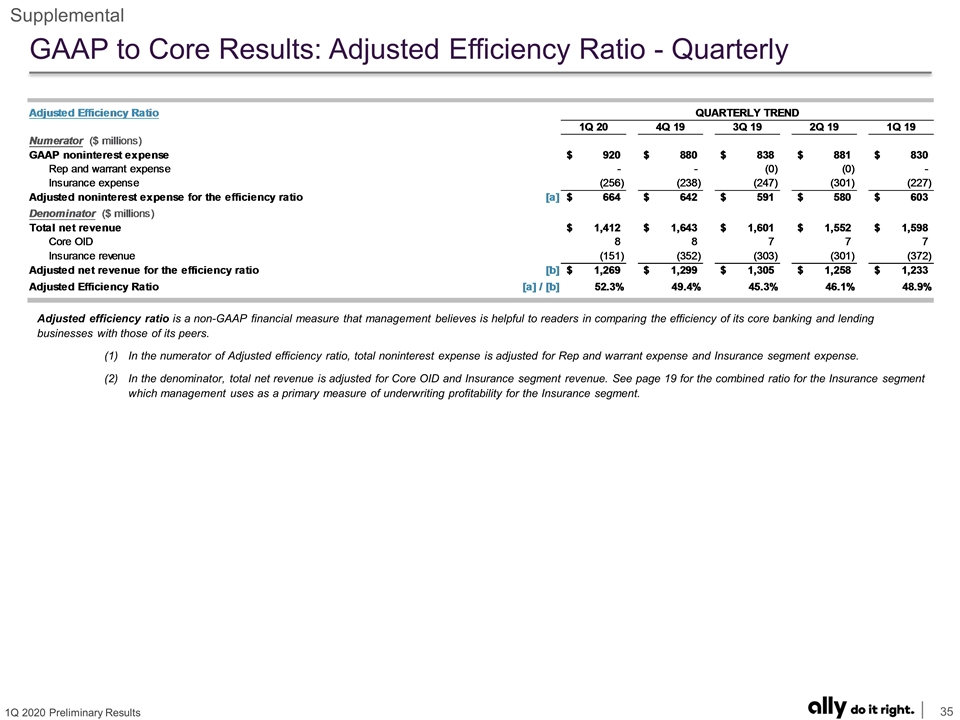
GAAP to Core Results: Adjusted Efficiency Ratio - Quarterly Supplemental Adjusted efficiency ratio is a non-GAAP financial measure that management believes is helpful to readers in comparing the efficiency of its core banking and lending businesses with those of its peers. In the numerator of Adjusted efficiency ratio, total noninterest expense is adjusted for Rep and warrant expense and Insurance segment expense. In the denominator, total net revenue is adjusted for Core OID and Insurance segment revenue. See page 19 for the combined ratio for the Insurance segment which management uses as a primary measure of underwriting profitability for the Insurance segment.
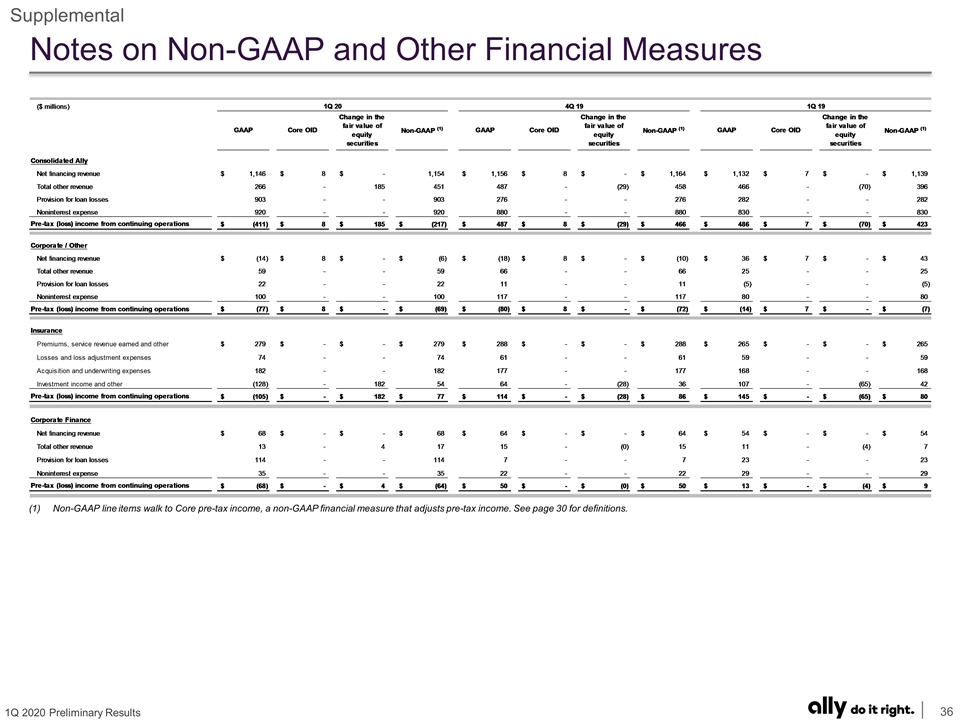
Notes on Non-GAAP and Other Financial Measures Supplemental Non-GAAP line items walk to Core pre-tax income, a non-GAAP financial measure that adjusts pre-tax income. See page 30 for definitions.
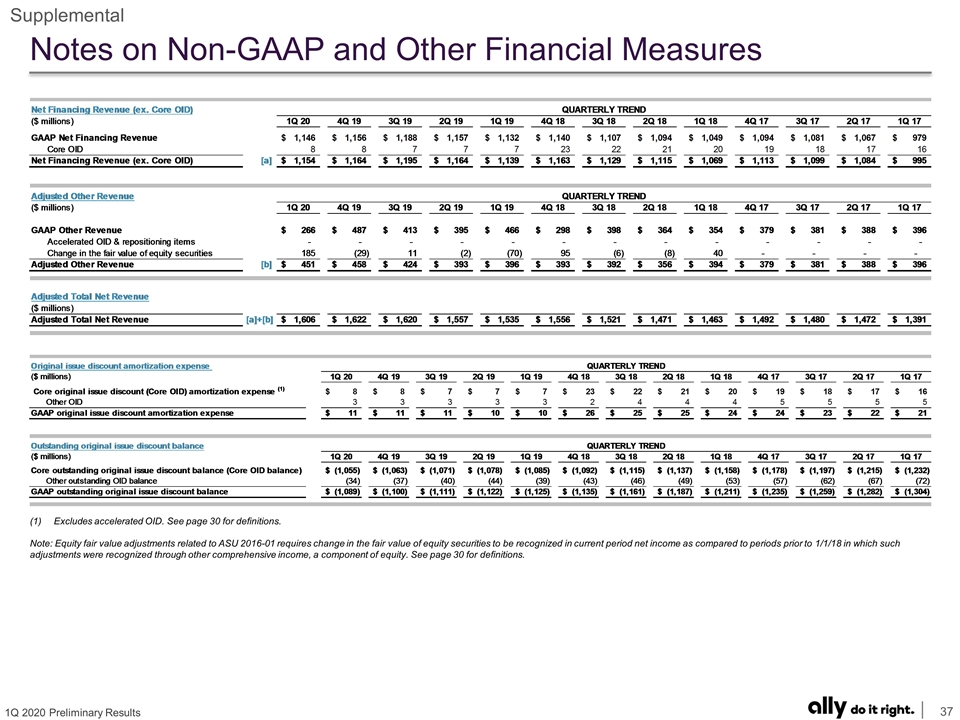
Notes on Non-GAAP and Other Financial Measures Supplemental Excludes accelerated OID. See page 30 for definitions. Note: Equity fair value adjustments related to ASU 2016-01 requires change in the fair value of equity securities to be recognized in current period net income as compared to periods prior to 1/1/18 in which such adjustments were recognized through other comprehensive income, a component of equity. See page 30 for definitions.




































